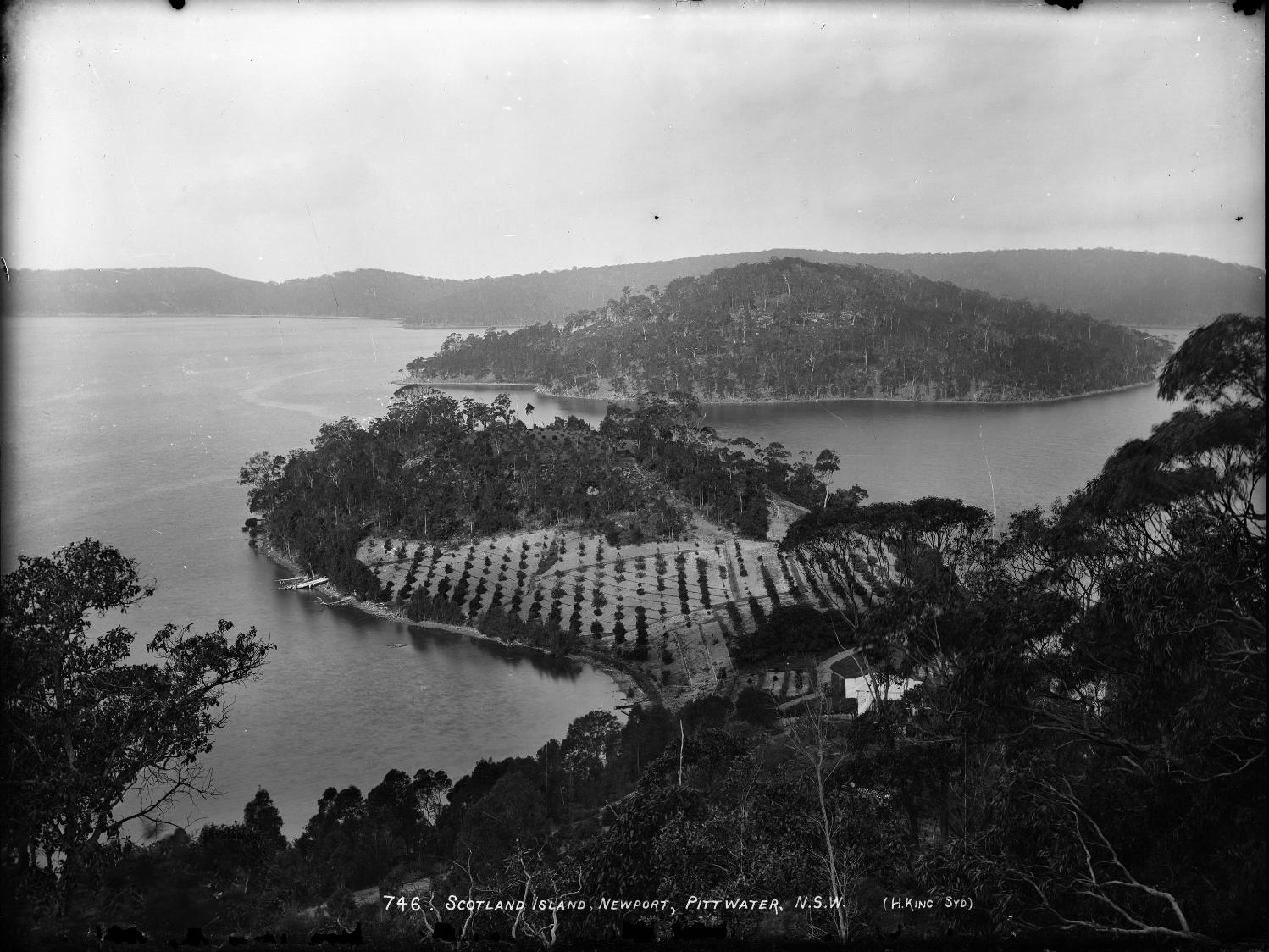June 20 - 26, 2021: Issue 499
Pittwater's Tropical Fruits: From The Middle Of Winter
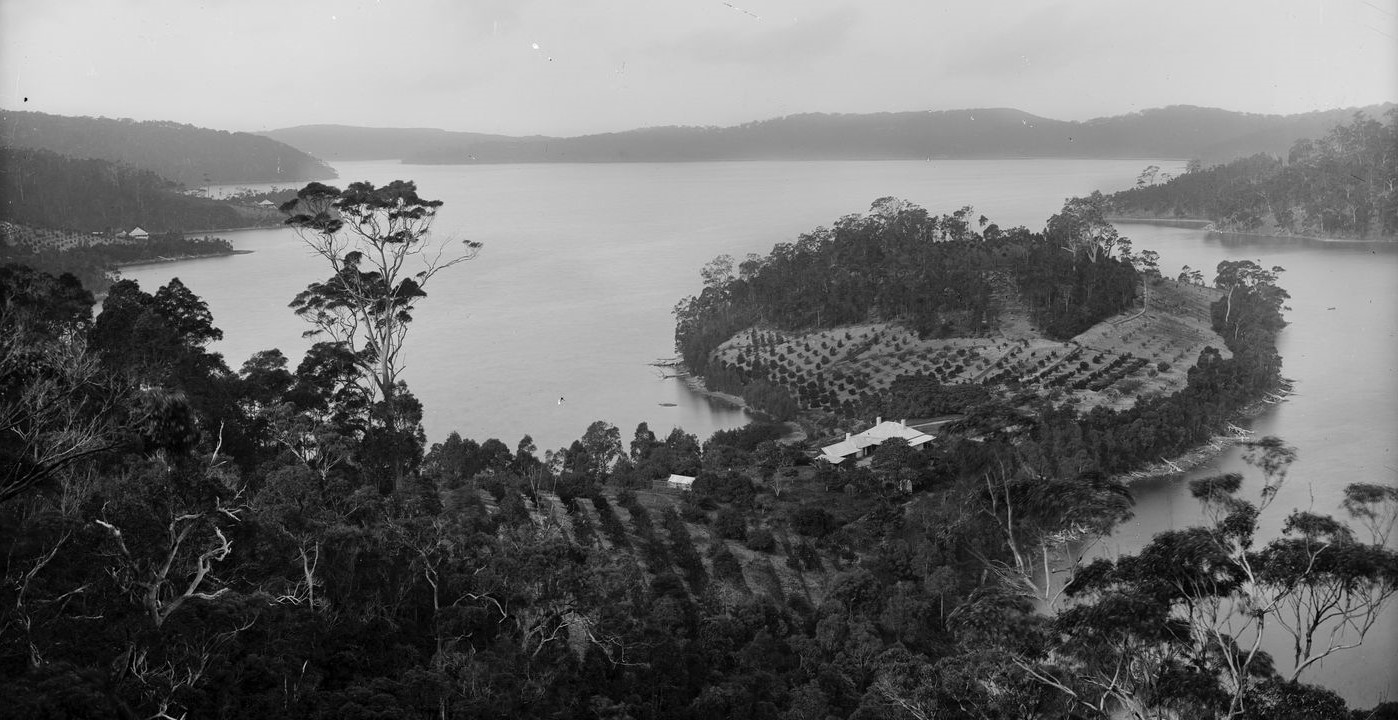
'At Pittwater' by Charles Kerry, circa 1887-1888. From Tyrell Collection, courtesy Powerhouse Museum - is Rocky Point, Elvina Bay to left, Lovetts' Bay to right and Scotland Island
The State Library of New South Wales, in its ongoing digitisation of materials and making these available for the populace, has recently added the following photographs of a 'tropical fruit orchard at Pittwater' which, according to the sources, were taken on July 11th, 1938, possibly taken for Woman magazine or Woman: Incorporating the Woman's Budget - a woman's magazine published in Sydney, by Sungravure [Sun newspapers] from 1934 to 1954 with Issues originally cost three pence each.
Among these images of paw paws, bananas, strawberries, pineapples and more appear some 'models' and one of the farmer or caretaker with a tomato vine:
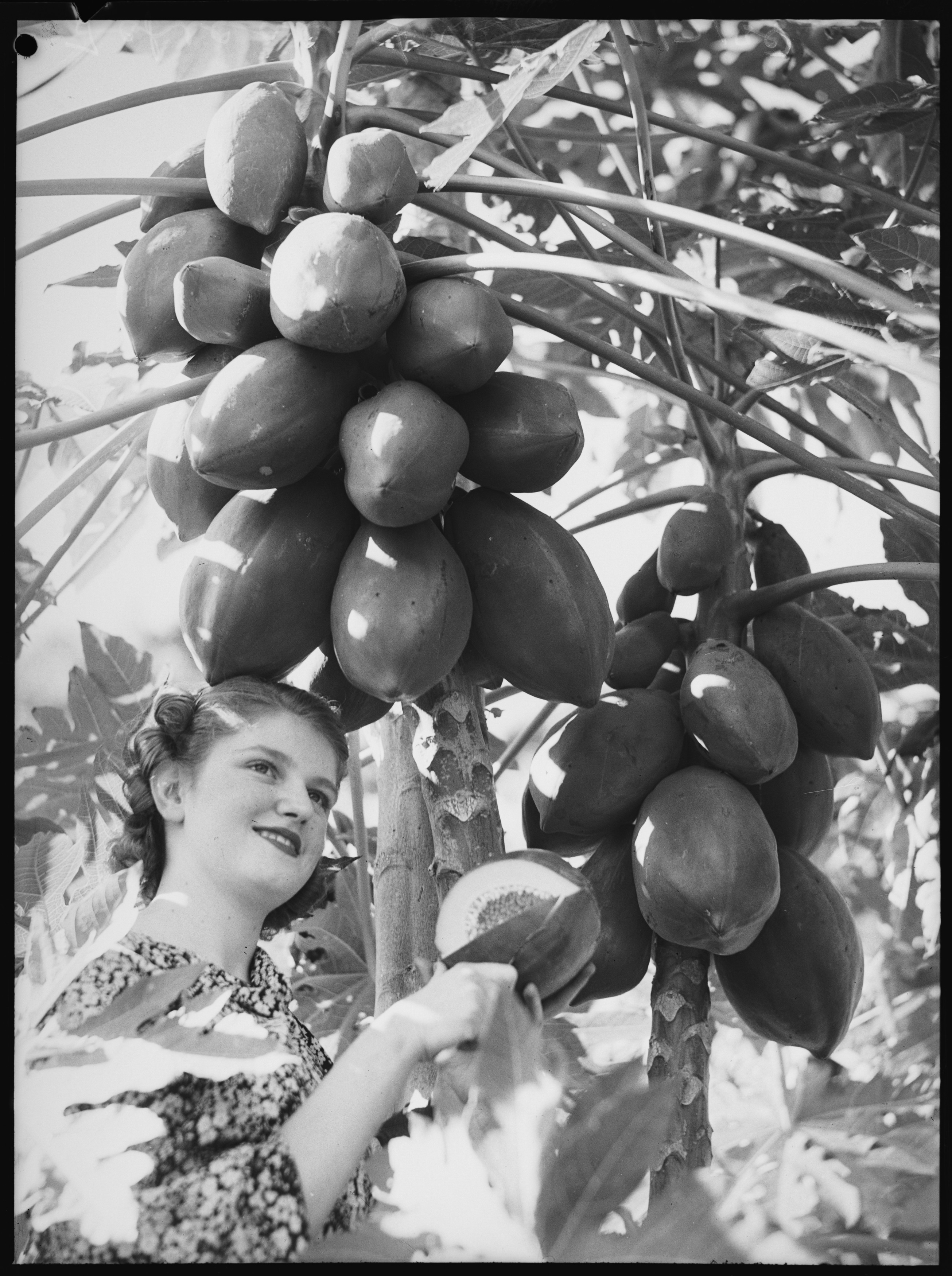
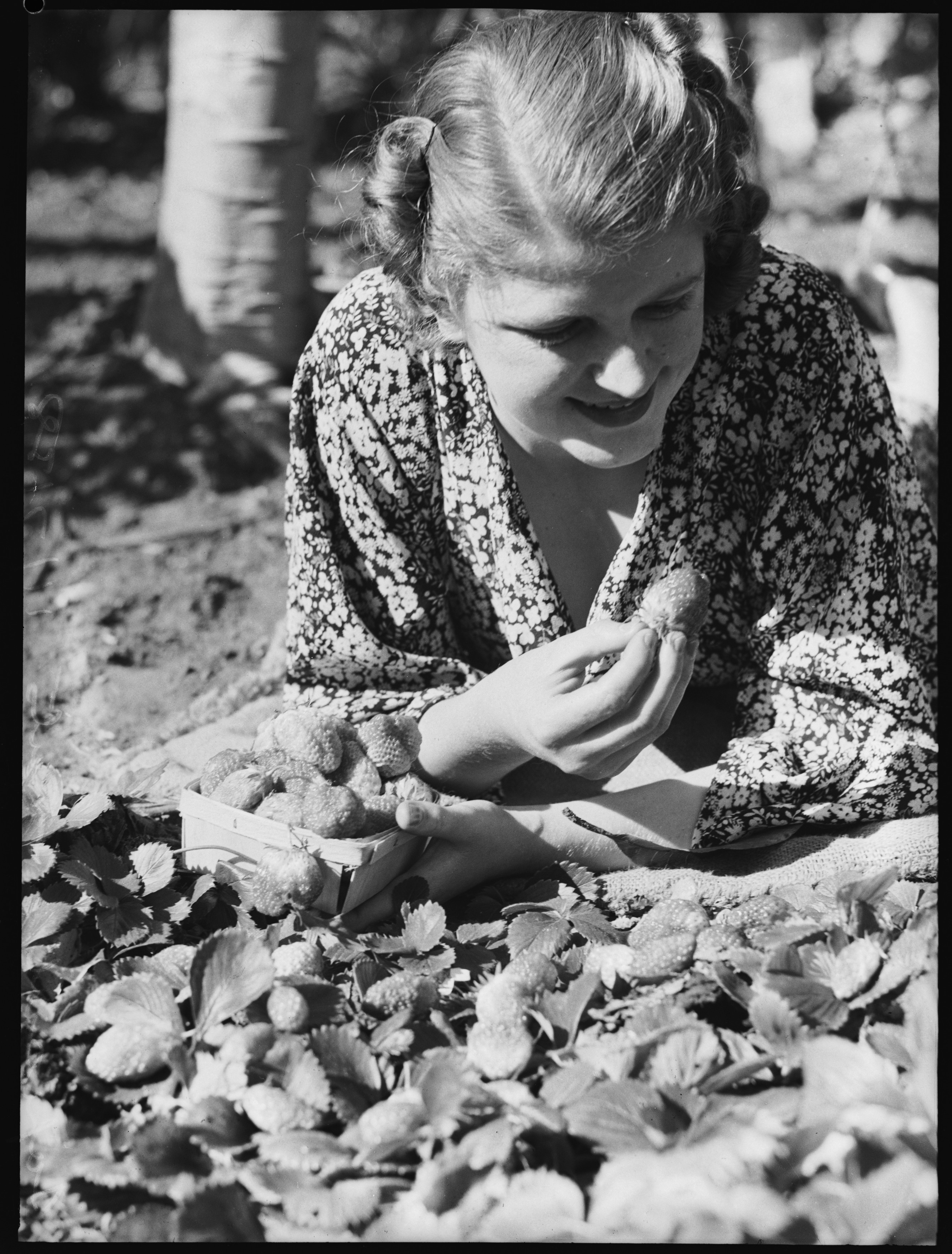
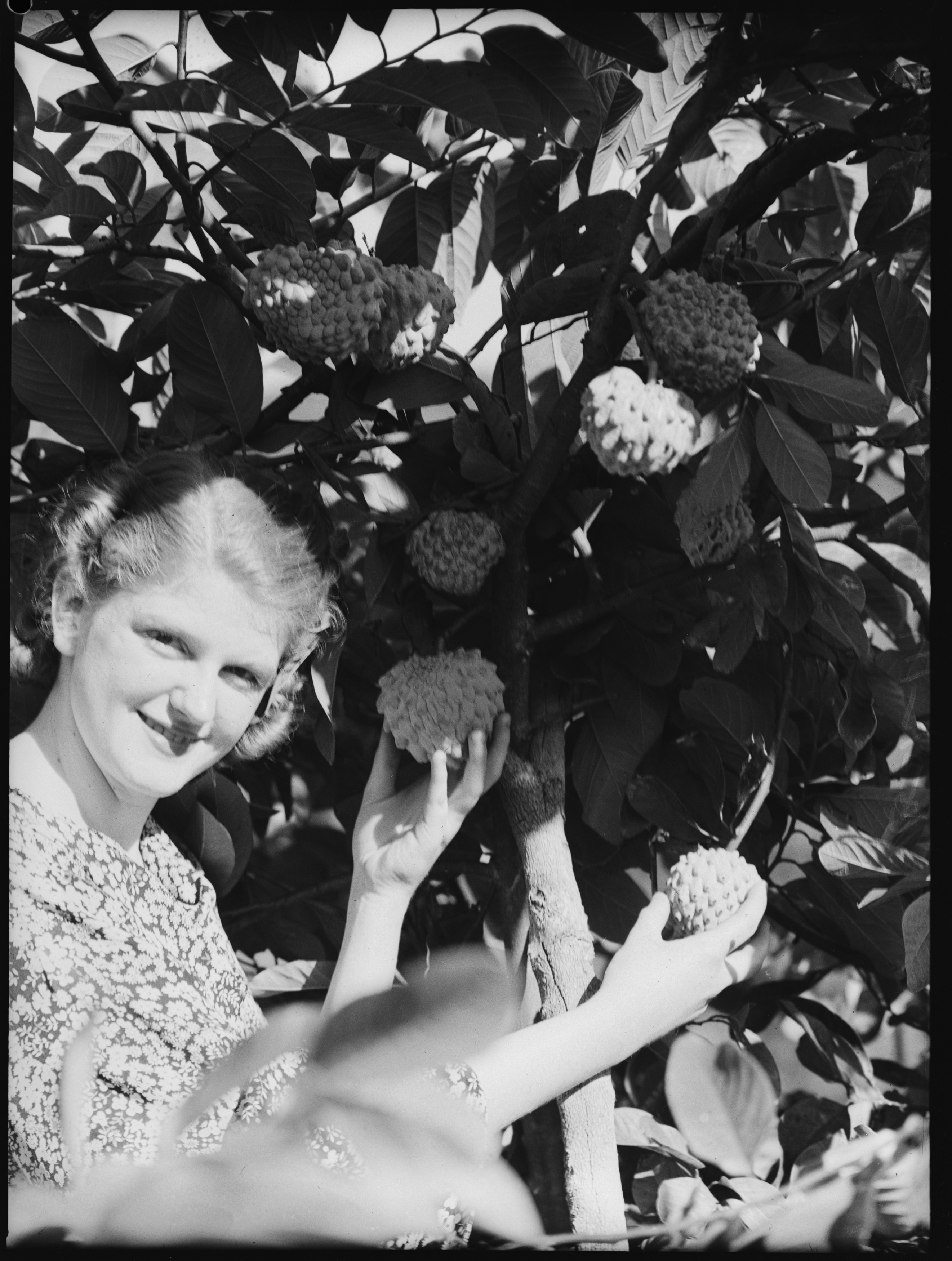
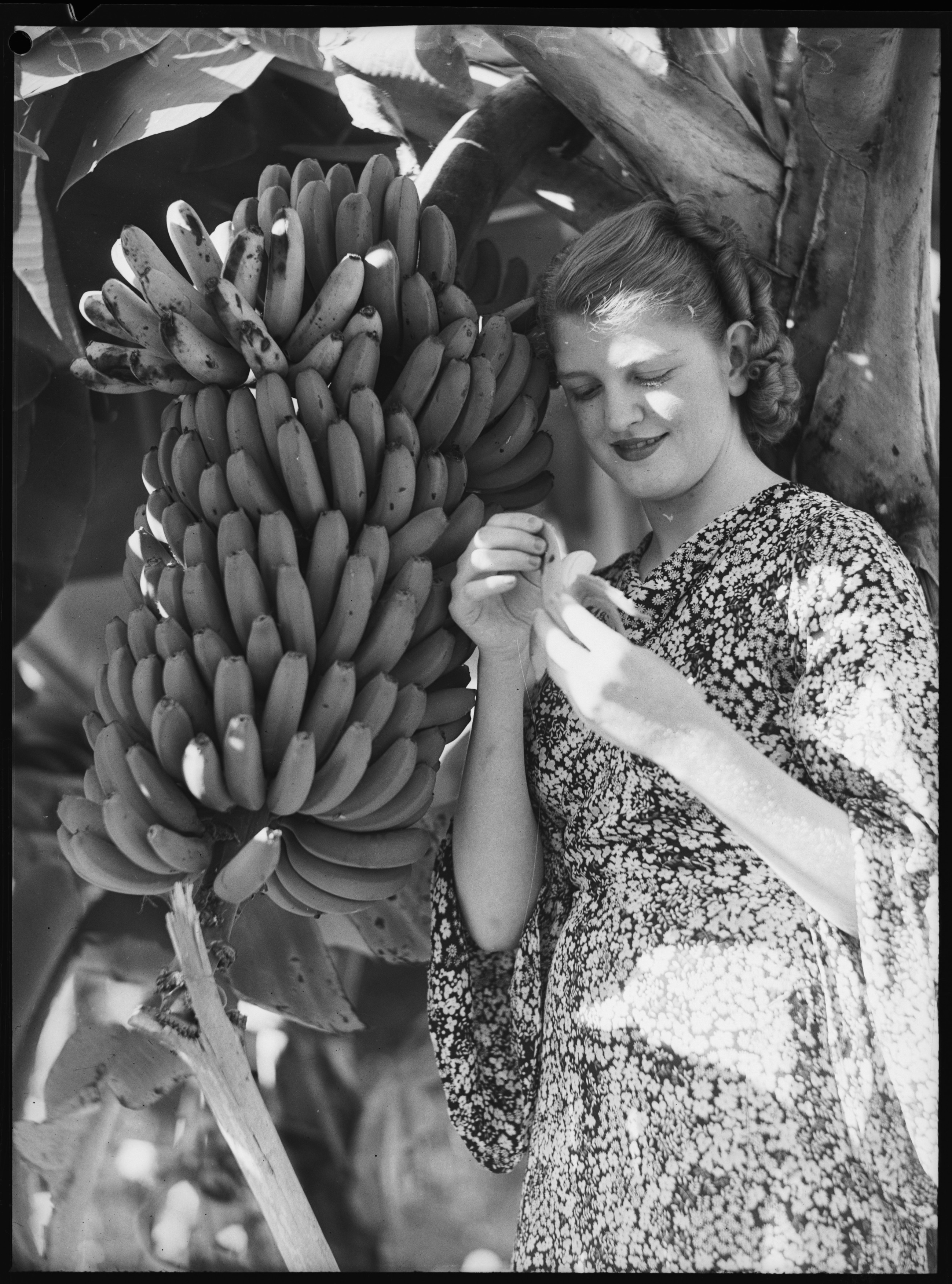
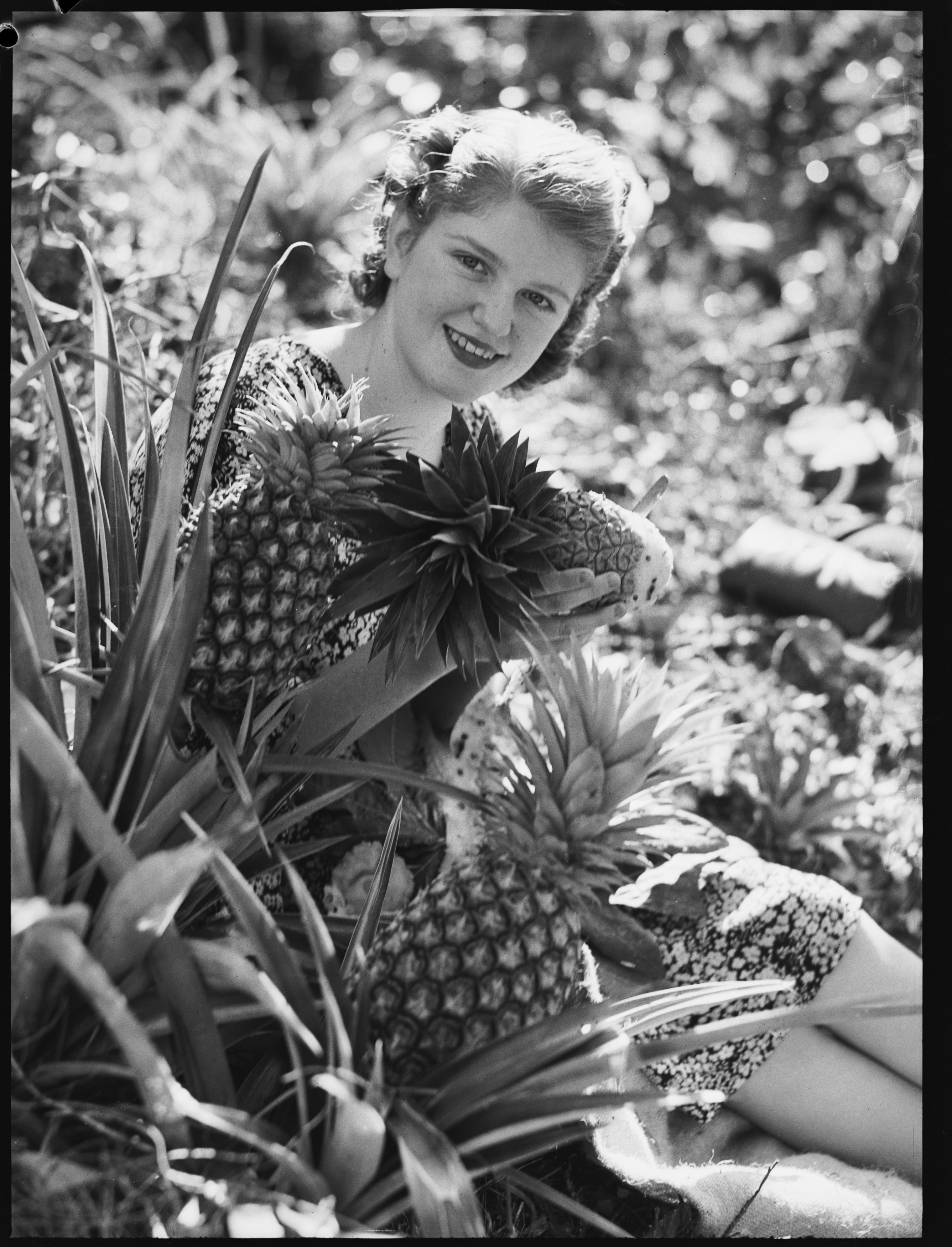
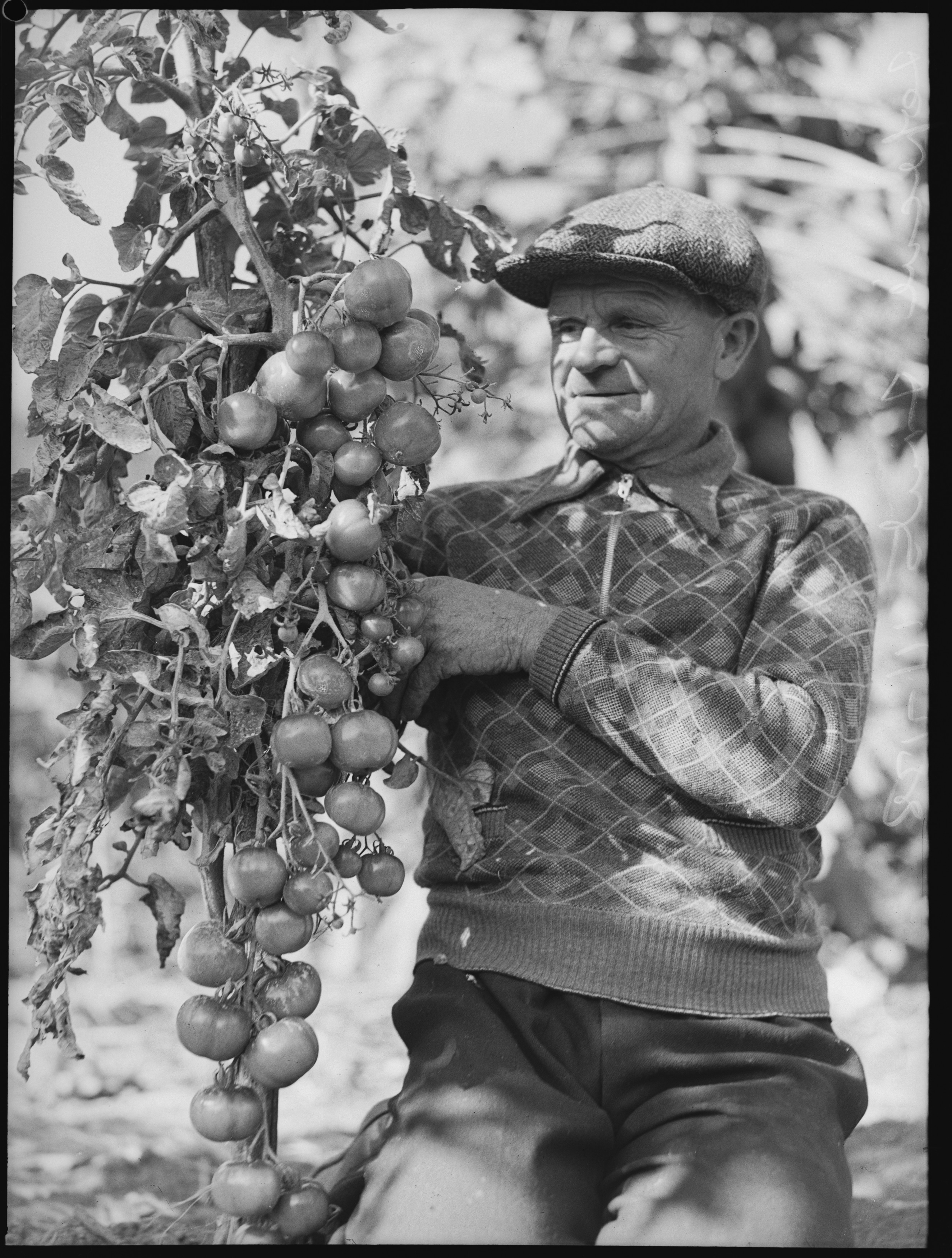
Tropical fruits - Pittwater, 11 July 1938, Items e22939_0001_c to e22939_0022_c, courtesy Mitchell Library, State Library of New South Wales
Yes; tropical fruits in a tropical fruit orchard, in Pittwater, in Winter!
Another from the same publishers appears in their daily newspaper a few months later:
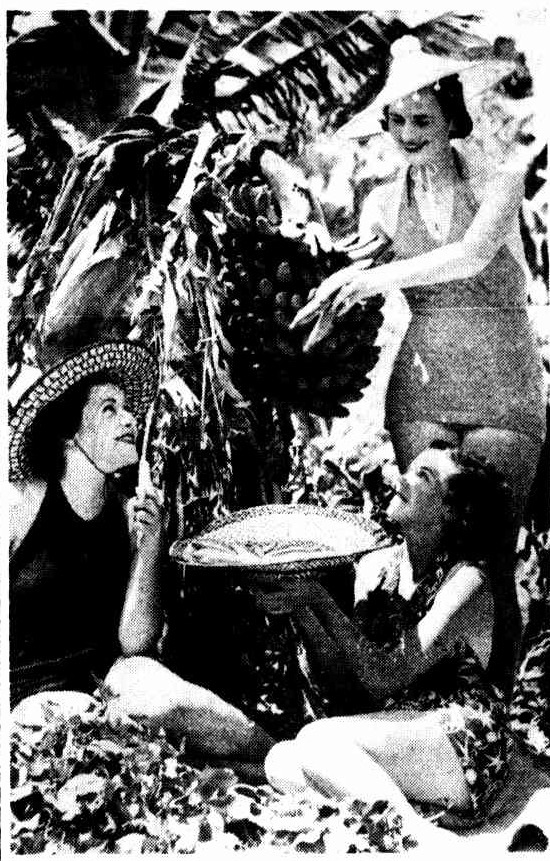
Bananas straight from the palm! Misses Madeline Fester (standing), Joyce Bain (left) and Kathleen Wills sample luscious fruit grown in a Pittwater tropical fruit orchard. No title (1939, February 18). The Sun (Sydney, NSW : 1910 - 1954), p. 3 (LAST RACE). Retrieved from http://nla.gov.au/nla.news-article229474524
This is preceded by:
MEN WHO LIVE IN GLASS HOUSES AND NOBODY THROWS STONES AT THEIR INDUSTRY
One stream of the flood of foreign migrants pouring into Australia consists of Yugoslavs, 642 of whom, according to the latest official report, came into the country during the 12 months to the end of August. Since then, the influx has increased.
An opportunity to study them is provided at Mona Vale, where more than a hundred practically live in glass houses.
Any dwelling in that area gives a wrong impression of its owner's, financial standing. His neighbors estimate his success not by the way he lives, but by the -number of glass houses he owns.
Less than 10 miles from Manly, Pittwater-road comes to a low hill around which it throws an arm, "Warriewood-road. When this by way gets out' of sight of the main thoroughfare it sweeps in a wide curve to Elanora Heights. At this end of Warriewood-road, and in the deep valley that runs across it from Vineyard-street to MacPherson-street, live the men of the glasshouses — Yugoslavs. In the open valley, on the side of the hill, and through the trees in every direction, what appear to be huge patches of snow gleam under the hot rays of the sun which no breeze tempers. But they are white-washed glasshouses which cover early tomatoes.
Hundreds of Yugoslavs who have seen or heard about the valley are driving picks into the faces of Broken Hill mines or cutting cane under Queensland's tropical sun, so that some day, perhaps in 10 years, they, too will own glasshouses. It is impossible to become even a humble member of the community without an outlay of at least £800. Land costs from £200 an acre, an over-valuation, based on what they have achieved, with their glass houses, say the growers.
Then it has to be cleared and fenced and water-piping connected. Moreover, it takes from 12 to 18 months to get the first houses going, during which the new arrival sometimes plants in the open.
The average holding is four acres, but some own as much as 12 acres. Although a glasshouse measures only 100ft. by 15ft., it has to be moved every two or three seasons.
Timber, glass, and other materials cost £70, and, when finished, with piping along each row, a house represents an outlay of £100. A double house is 100ft. by 30ft„ . and correspondingly more expensive.
Early glasshouse tomatoes are marketed from August to November, and those grown outside until the end of December. The glasshouse grower, therefore, has a two months' start on the ordinary producer. Consequently, his tomatoes bring 6d a lb., as compared with 4d or 3d.
One grower recently obtained the record price of 2s 6d a lb.
Fine Physique
Unlike many of the other Southern Europeans, these Yugoslavs are fine physical specimens who have been reared on the land in their own country. Most of them have wives and families, who add their share of manual labor. Three of the wives are Australians.
Here are some of the leading personalities among them: — Pioneer of the settlement is George Jovanovich, J.P., who married an Australian girl, and started with two glasshouses in 1927. When his holding carried 20 houses he sold out to compatriots, and now lives in retirement in Parramatta-road, Annandale. But his brother, Percy, has his bachelor quarters in the oldest building of the settlement.
Three Sydney business men started their careers in it when they raised poultry there 40 years ago.
"When I come here eight years ago I spend all the money I made cutting cane in Queensland," he said. "Then I have eight houses, but I owe £1250. Now I have 13 houses, and I have no debts."
The opulence of Laurich and Vladimir Milos glistens when the sun shines on their 40 houses. They also have their own car and motor lorry.
Wives Must Wait
Mile Chanak now has 30 houses and a lorry. He tolled in the Broken Hill mines and among the tomatoes 12 years before he felt affluent enough to bring out his wife and two children three years ago. A third has since been born.
Antonio Slavich, with the help of a Serbian wife and three sons, works 20 houses; Kalajizich, Papec, and Antonvich run 24 houses in a sort of partnership; Steve Tasich, there three years, has three houses, a wife, and four children; Chemichierc came from Broken Hill a year ago; the Rdaij brothers are still growing in the open, and so is Sarvo Szentich, who, after two years, is waiting for a good season to send for his wife and family.
Many of the new arrivals work for Kunich, who employs about 100 fruit-pickers at his cherry orchard at Young. Kunich is said to be the wealthiest Yugoslav in Australia. MEN WHO LIVE IN GLASS HOUSES-- (1938, November 13). The Sun (Sydney, NSW : 1910 - 1954), p. 23 (NEWS SECTION). Retrieved from http://nla.gov.au/nla.news-article231136788
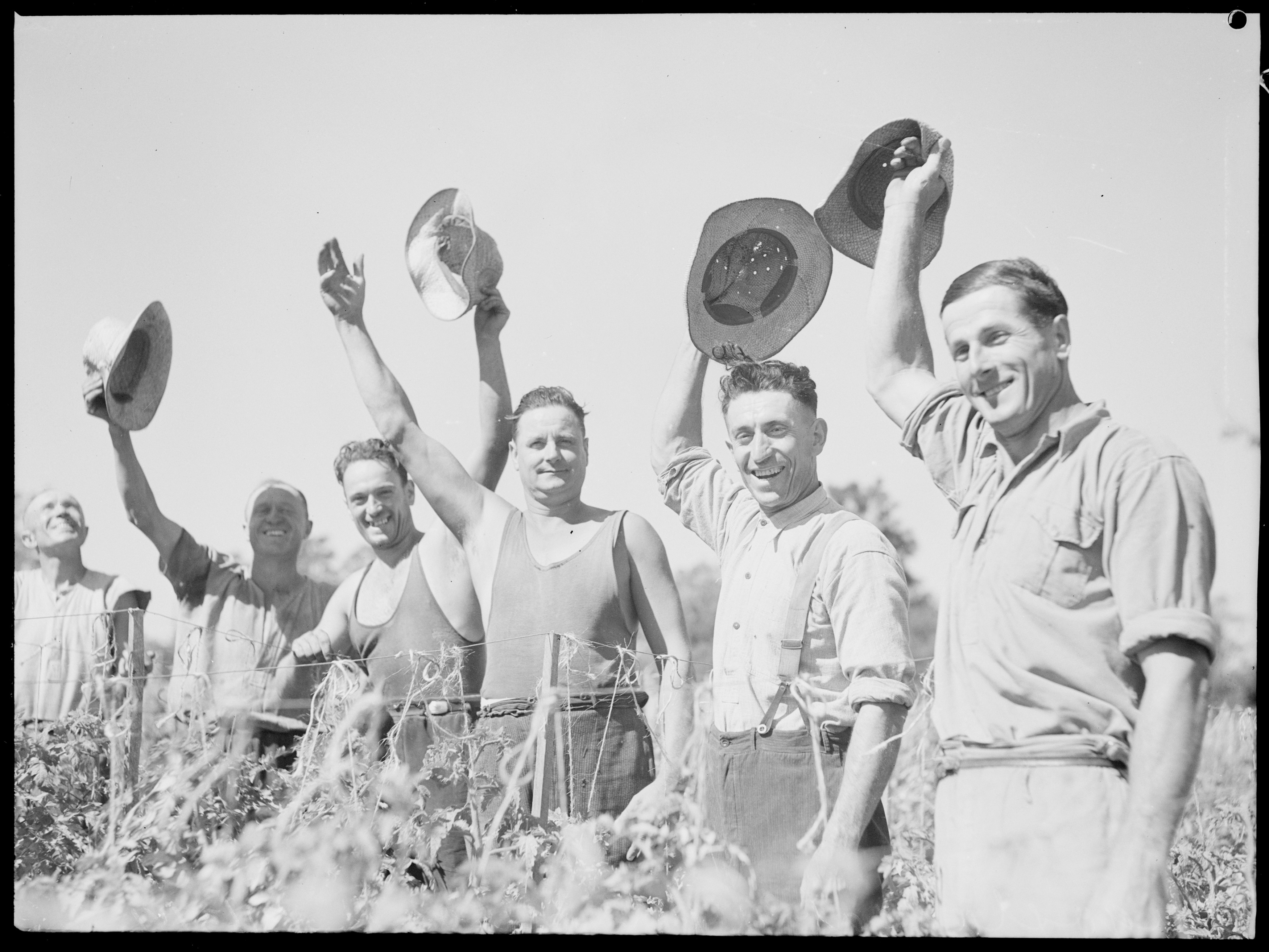
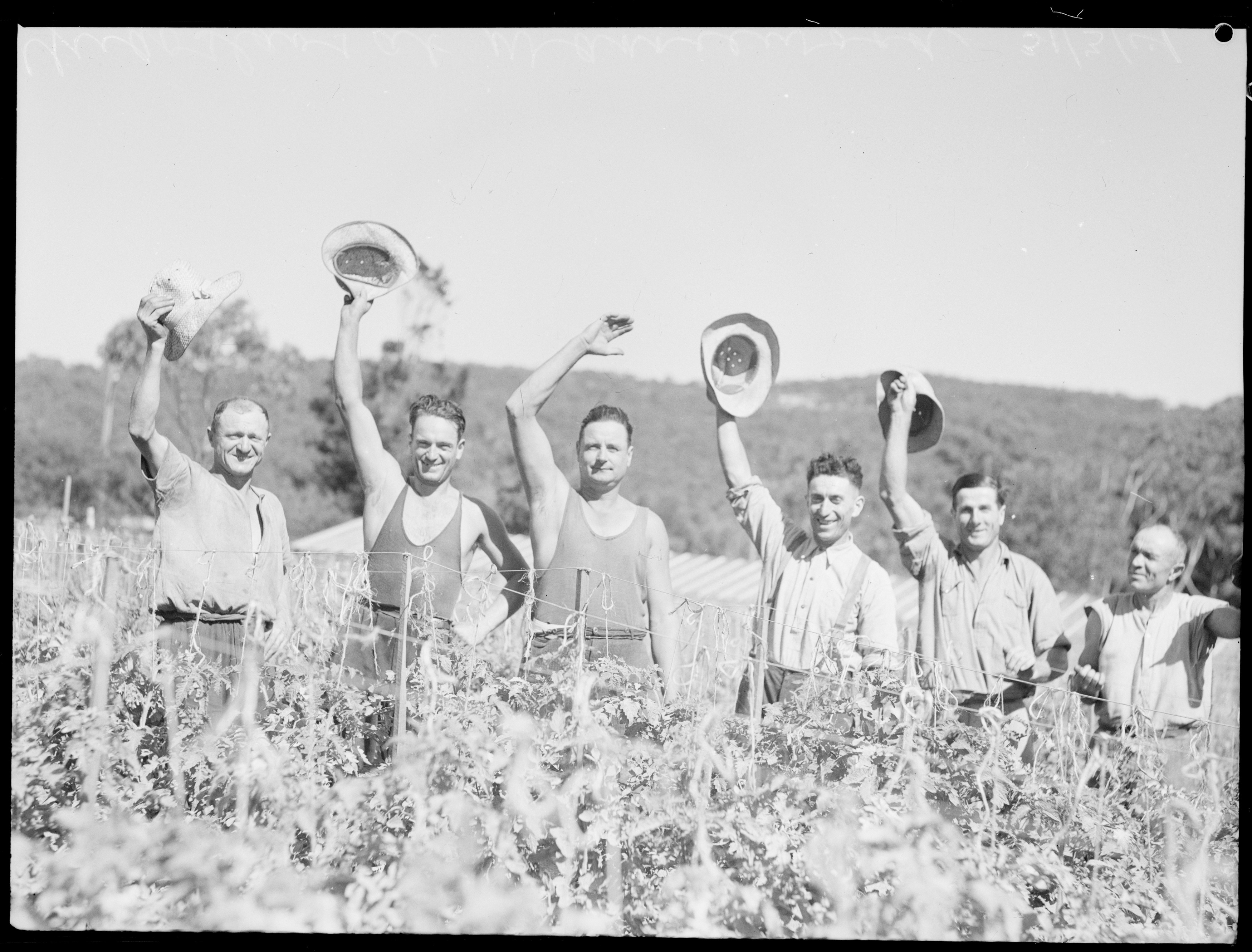
Yugoslavs at Warriewood, 8 March 1941 - envelope dated 31/3/1941. Assumed by Library volunteer to be Sun; other envelopes in sequence marked "DS". Items e13170_0001_c and e13170_0004_c, courtesy Mitchell Library, State Library of New South Wales
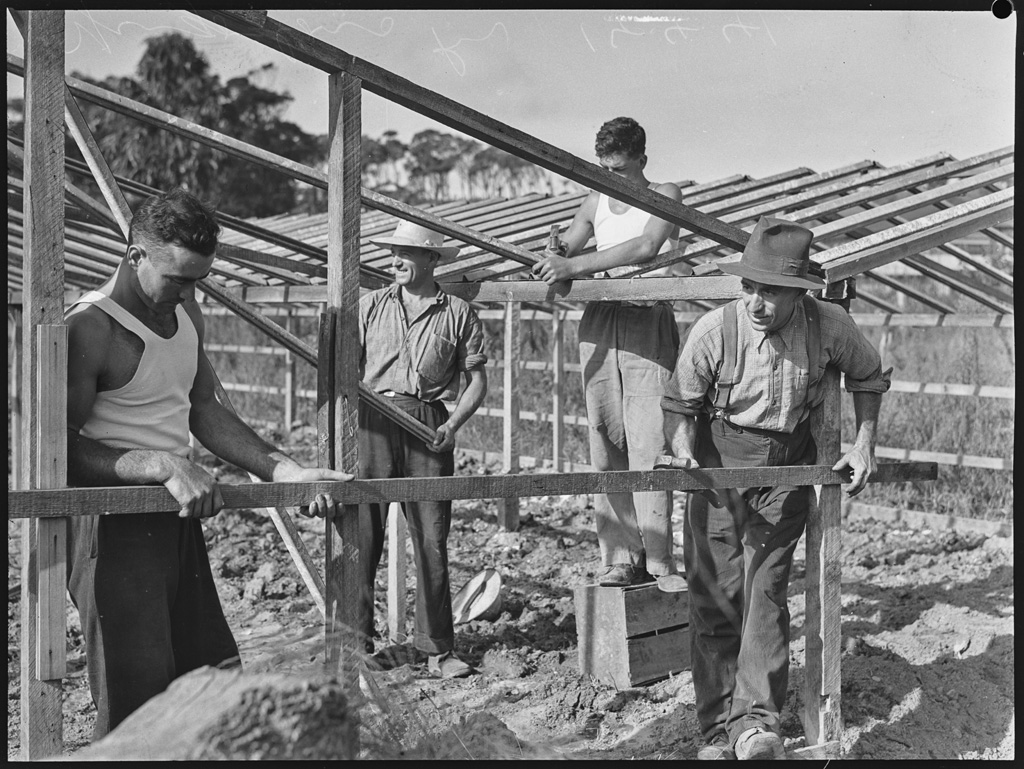
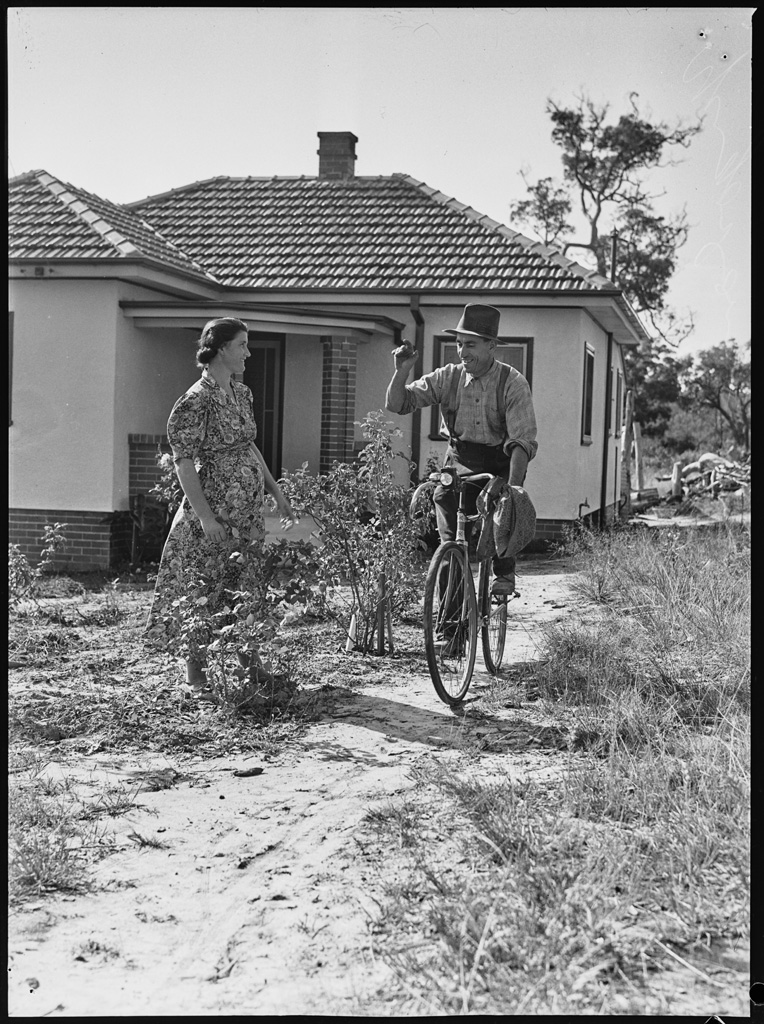
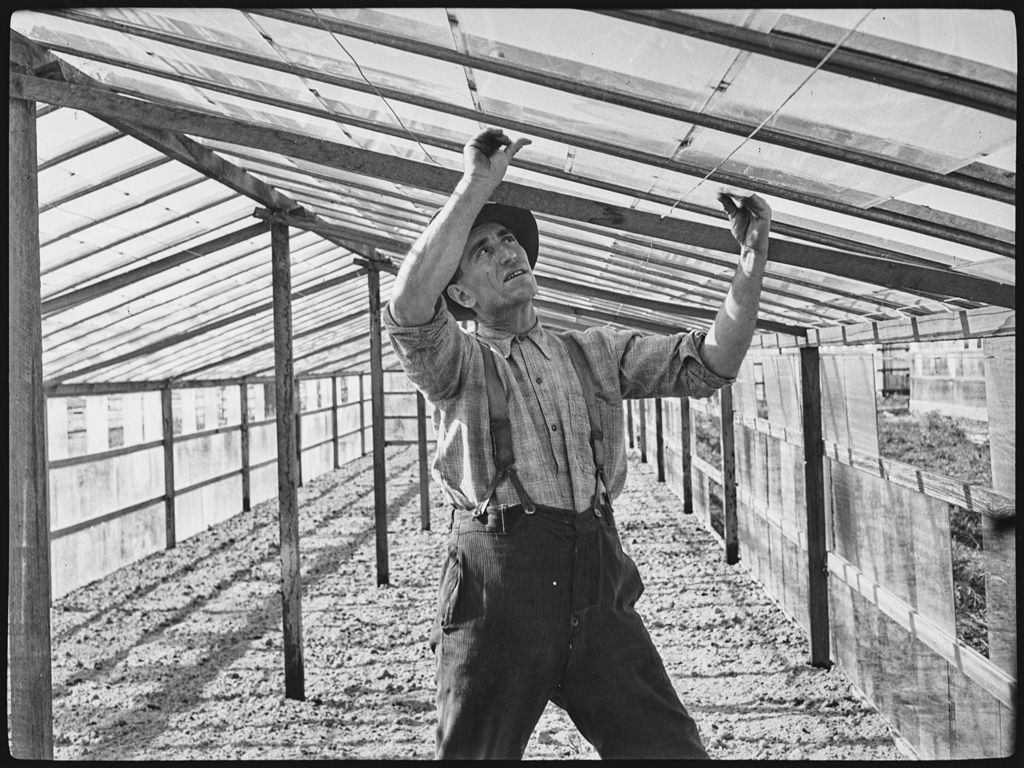
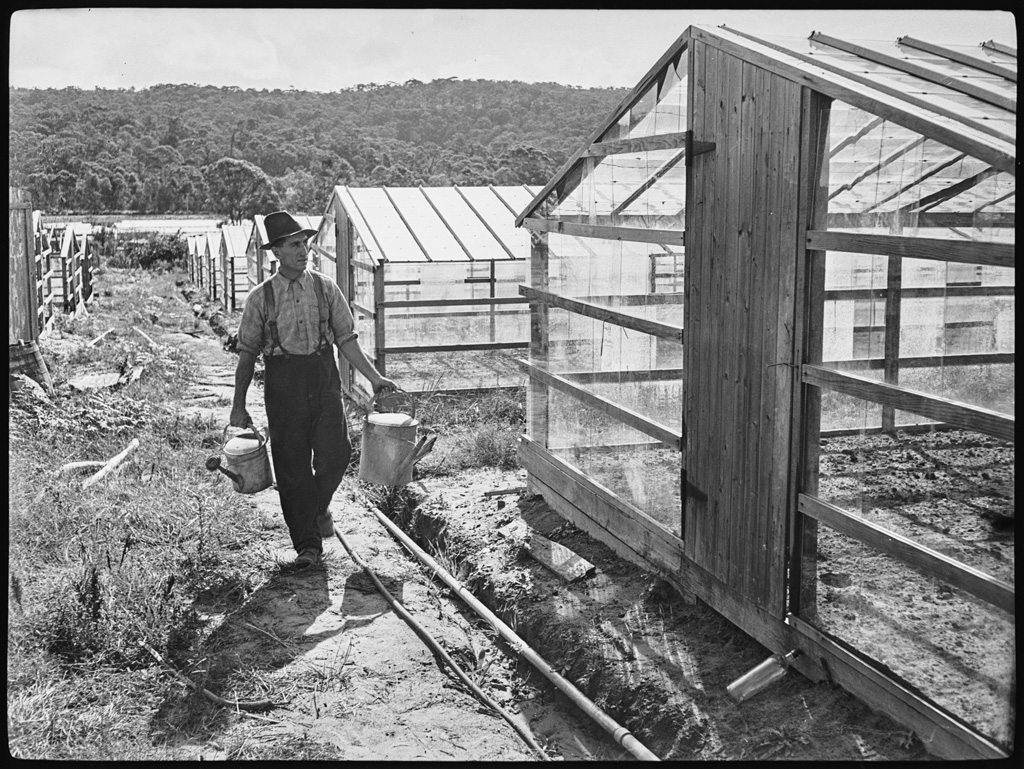
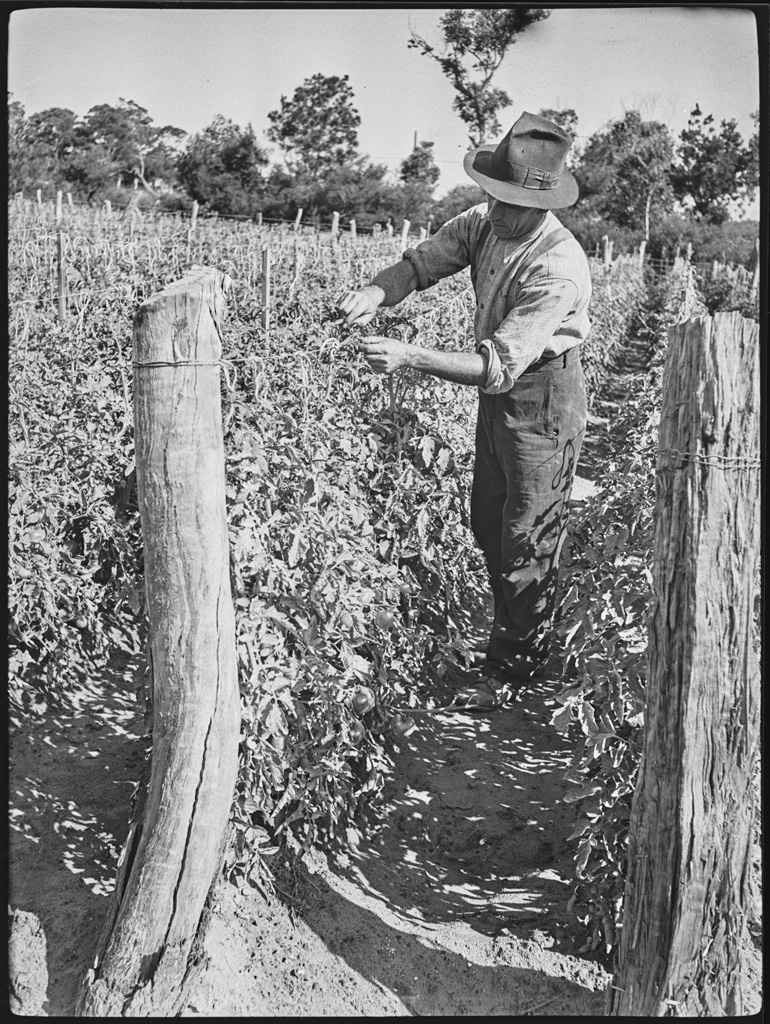
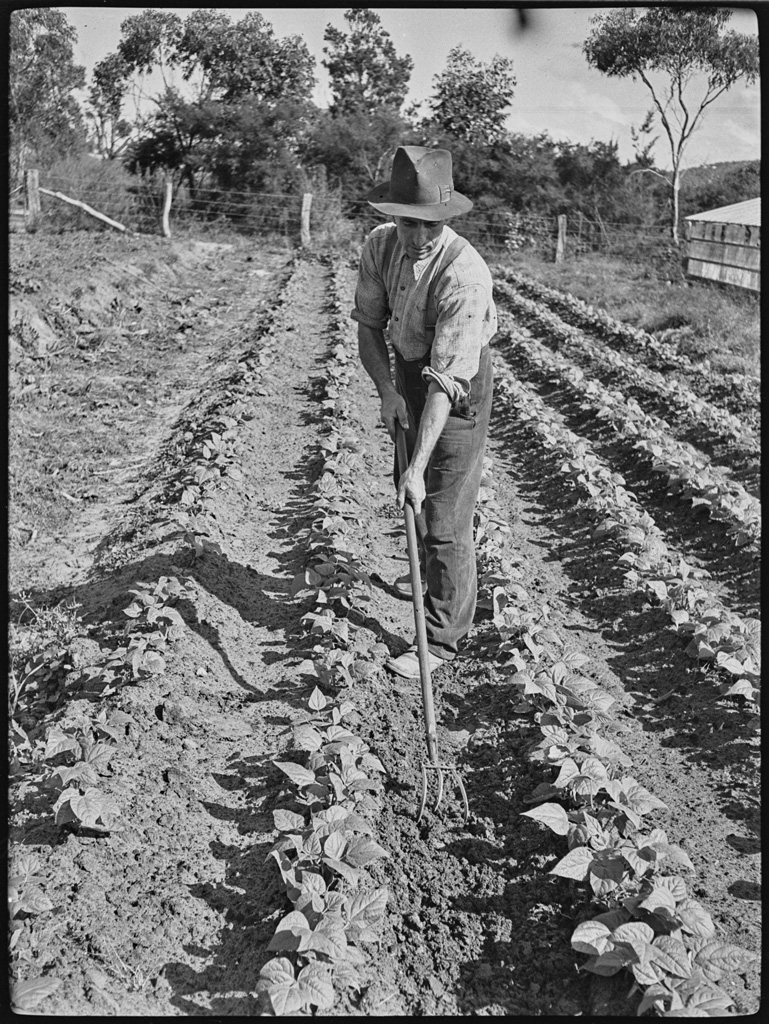
Yugoslavs' farm at Warriewood, 7 April 1941 / photographed by R. Donaldson, Title and date from original envelope housing negatives or devised by Library volunteers, Items: c19019_0002_c, c19019_0005_c, c19019_0017_c, c19019_0019_c, c19019_0021_c and c19019_0022_c courtesy Mitchell Library, State Library of New South Wales and Courtesy ACP Magazines Ltd.
Earlier articles all raved about the tropical fruits on properties on our western shores, so clearly a suntrap sheltered position worked best for these fruits. The property of Robert Robinson at Towlers' Bay was well-known for this and mentioned a few times:
On the Towler's Bay side there are several residents who pull across the water to the wharf at Church Point and meet the steamer from Sydney or the coach from Manly, as the case may be. The dynamite powder hulk is moored in Towler's Bay, with residences on shore for the officers in charge.
Mr. Robert Robinson has his residence of Raamah at the same place. Mr. Robinson informs me that he can grow to perfection such tropical fruits as bananas, guavas, ginger, mangoes, pineapples, Brazilian cherries, &c. This fact will demonstrate that there can be little or no frost in this locality.
Other residents of this side of the bay are Mr. F. Chave, Woodlands, who has a very nice orchard, mostly summer fruit ; Mr. E. C. Johnstone, who has a nice residence and orchard; Mr. A. Steffani is another prominent resident, while the residence of the firm of Flood and Oately occupies a lovely peninsula in the quiet waters of the bay. Mr. Geo. Brown has a residence and an orchard in the neighborhood, and there is also a small church and cemetery at Church Point. Manly to Broken Bay. (1893, November 11). Australian Town and Country Journal (NSW : 1870 - 1907), p. 19. Retrieved from http://nla.gov.au/nla.news-article71191632
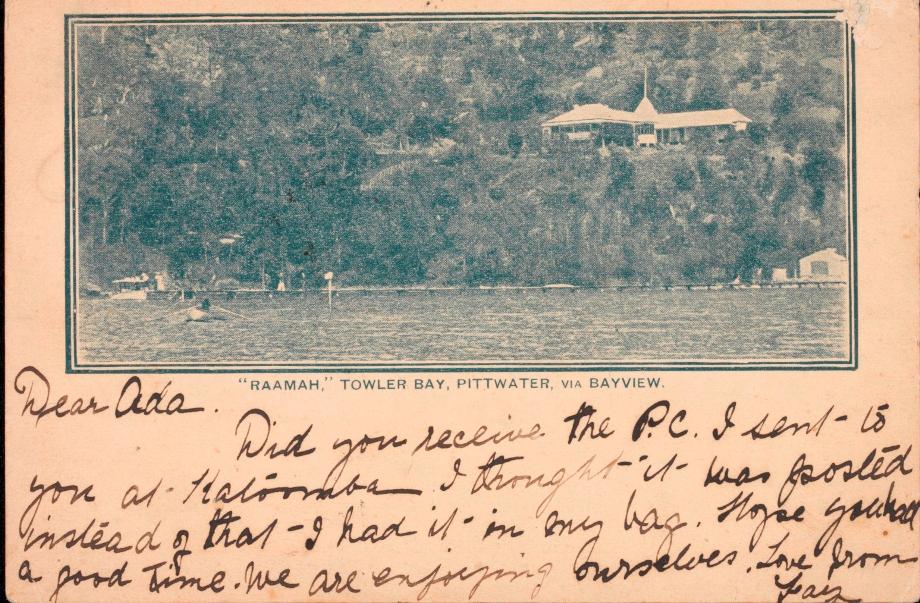
Some New South Wales Grown Mangoes.
Since the article on mango cultivation appeared in these columns, a great deal of Interest has been awakened in this valuable sub-tropical fruit. The other day Mr. J. S. Edgar brought to this office several very fine mangoes that had been grown in the late Mr. R. Robinson's garden at Pittwater, Broken Bay. The trees, which are now ab out five years' old, were obtained from the Botanic Gardens, Rockhampton, Queensland, and have some excellent crops this year. They are growing in a deep, rich soil, about 50ft above sea level, and are a picture of health.. Notwithstanding the very dry season that has been experienced, the fruit is well developed and of good flavor. The mango trees at Pittwater go to prove that this sub-tropical fruit can be produced in sheltered positions in the neighborhood of Sydney. " Some New South Wales Grown Mangoes. (1899, March 11). Australian Town and Country Journal (Sydney, NSW : 1870 - 1919), p. 17. Retrieved from http://nla.gov.au/nla.news-article71325097
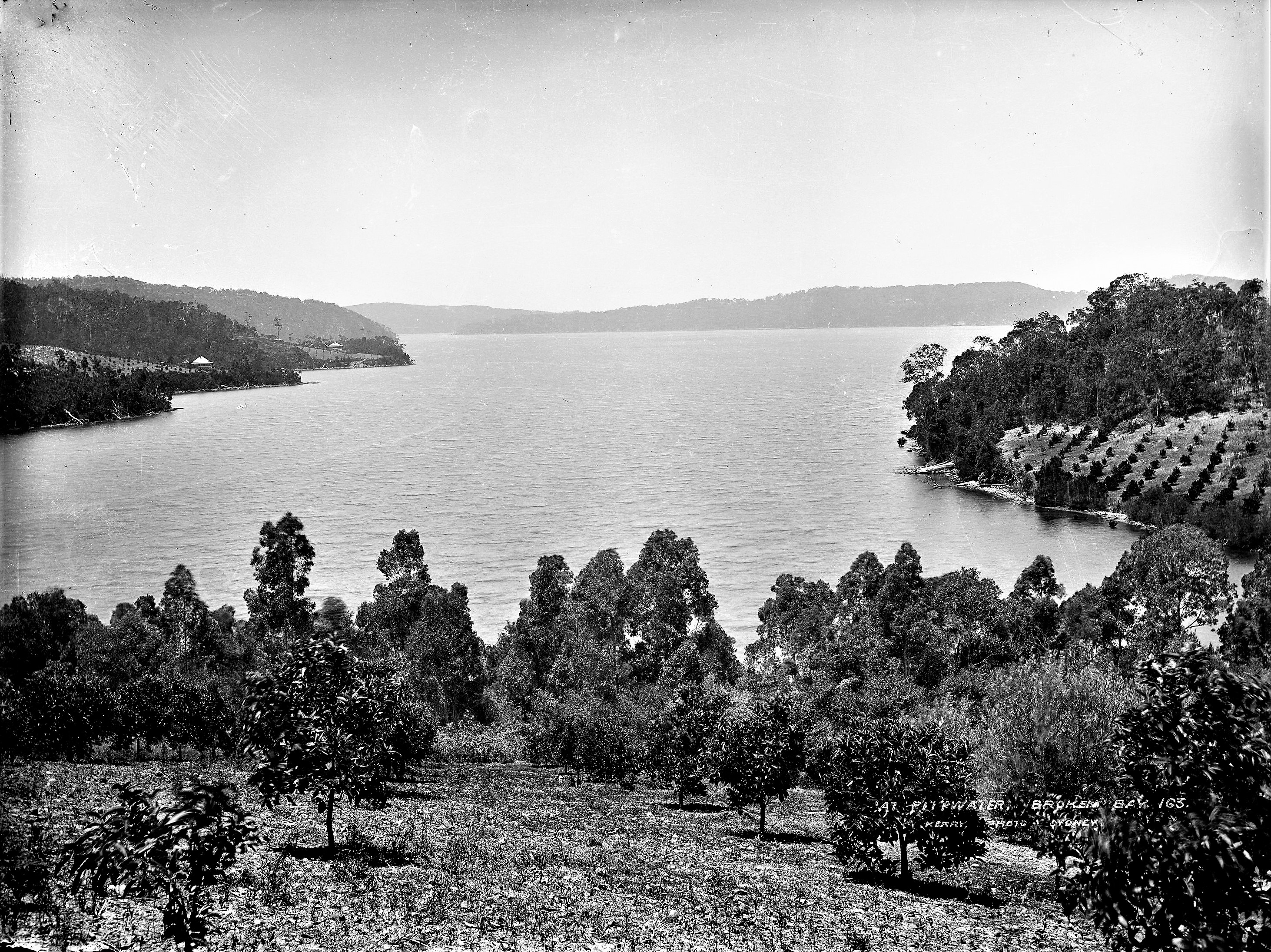
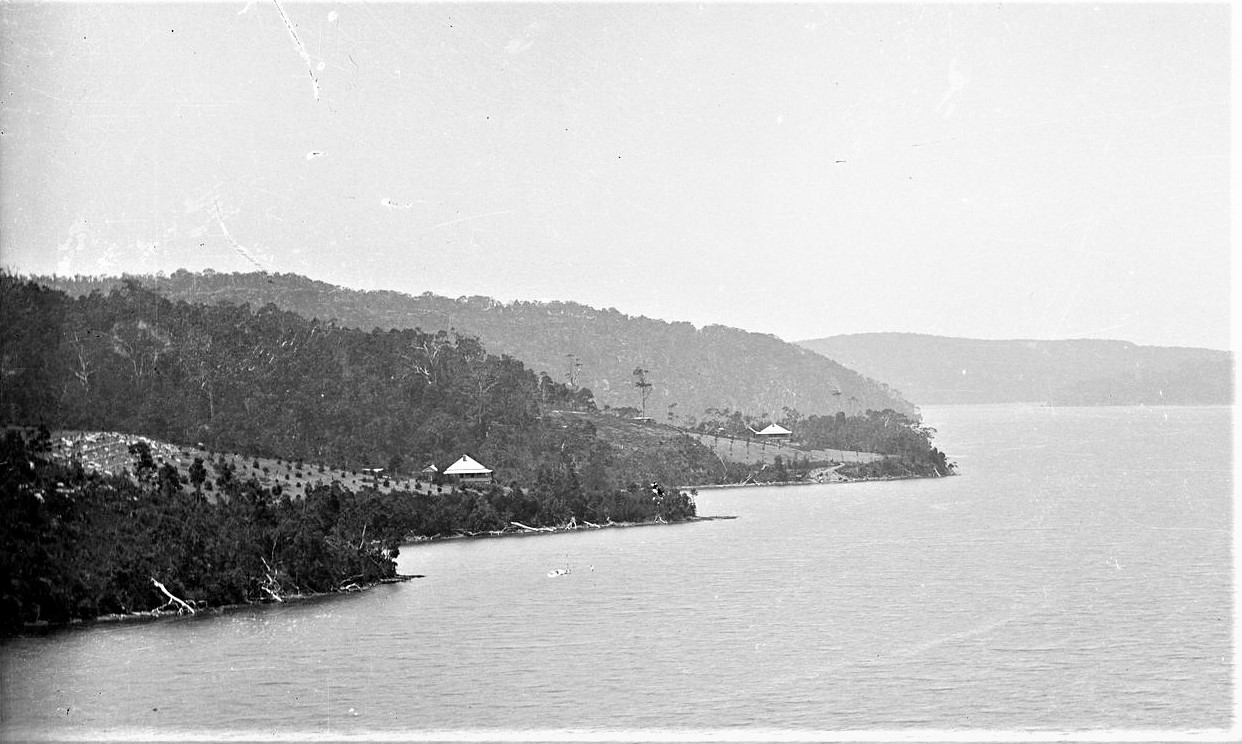
Lovett Bay circa 1883-1887, by Charles Kerry & Co. part of the Powerhouse Museum's Tyrrell collection, and section from to show homes/orchards around Towlers' Bay
The sheltered nooks of Towlers' Bay aren't the only place offshore that had an early reputation for having the right soil and the right shelter to grow tropical fruits, this gentleman on Scotland Island for instance during those same mid to late 1930's:
HISTORIC ISLAND DESERTED
Scotland Island, Pittwater, one of the first places to be explored by Governor Phillip, is now nearly as deserted as it was 150 years ago. Warringah Shire Council has received a complaint about the neglect of the Island.
"It would not be worth our while spending a lot of money on the island," said the deputy-shire clerk (Mr. W. U. Gors) yesterday. "The population at present numbers four. The place is almost deserted." In pre-depression days land was worth £10-£12 a foot on the island, which was all subdivided for weekend locations. HISTORIC ISLAND DESERTED (1937, May 8). The Daily Telegraph (Sydney, NSW : 1931 - 1954), p. 7. Retrieved from http://nla.gov.au/nla.news-article247144986
Contented Crusoe Of Scotland Is.
THE loneliest man near Sydney is Mr. Richard Empey, sole inhabitant of Scotland Island, Pittwater, 20 miles from the city.
He has lived alone as caretaker of an unoccupied house on the island for the last seven and a half years. Two cats, Poodles, black, and Mick, mouse-colored, are his only companions. "It's a treat to meet a human being," said Mr. Empey when visited yester-day. Scotland Island was explored by Governor Phillip, and once, it is said, bush rangers buried stolen gold there.
Fruits Of Toil
While on Scotland Island, Mr. Empey has built a beautiful terraced garden. "I grow all tropical fruits here, and get my water from tanks," he said. A motor launch from Church Point calls daily at his small jetty. He said he had had the Daily Telegraph sent to him with his provisions and equipment every day of his exile.
No Modern "Contraptions"
"I have no radio, telephone, or any modern contraption, but I like to know how the rest of the world is getting on," he said. Asked if he were happy as a modern Crusoe, he said: "I am perfectly happy here. I do not like the bustle, noise, and rushing of the cities." There is a cloud on Mr. Empey's horizon. The house which he looks after is for sale, and he does not know whether the new owner will want a caretaker. Contented Crusoe Of Scotland Is. (1937, May 10). The Daily Telegraph (Sydney, NSW : 1931 - 1954), p. 7. Retrieved from http://nla.gov.au/nla.news-article247141838
Private Undersea Cable For Weekend Home
A PRIVATE submarine cable has been laid from the main-land to Scotland Island, Pittwater, to light a city business-man's weekend cottage.
The cable, which is half a mile in length, was installed by the owner of the cottage, Mr. H. W. Henderson, at his own expense. It is the first of its kind to be laid in Sydney by a resident for his own use. It was made In England by the Liver-pool Electric Cable Company, and weighs three tons and a half. It connects with the Warringah Shire's electricity system at Church Point. Carrying 460 volts, the power is sufficient to light a small township, the installation has been inspected by officers of the Warringah Shire Council, Mr. Henderson will hold a private switching-on ceremony at his cottage. Private Undersea Cable For Weekend Home (1937, October 15). The Daily Telegraph (Sydney, NSW : 1931 - 1954), p. 7. Retrieved from http://nla.gov.au/nla.news-article247236794
In 1898 the Wheeler family rent the Morrisons’ cottage ‘Killarney’ at Bay View at one pound per week with seabaths and a good boat included. Mr. J. S. N. Wheeler relates insights on this cottages in his 1940 published The Early Days of Bayview, Newport, Church Point and McCarr’s Creek, Pittwater:
: This has brought us to the twelfth mile-post from Manly. Along the road bordered with trees the coach descends to Figtree Flat, also known as Cape’s Flat, and the orchard of W. J. R. Baker, with “Killarney” cottage lying between the two. This flat with its green sward was a favourite picnic ground. The annual school picnic and distribution of prizes were held there on November 9 each year, the birthday of the then Prince of Wales (later King Edward VII.).
Baker’s orchard has long since disappeared. It comprised six acres of peaches, nectarines and other summer fruits, and two acres of oranges. The orangery was situated high up at the apex of the orchard. A row of quince and peach trees flanked the fence next to "Killarney." As Baker also kept poultry, it will be seen that Bayview was once a thriving poultry-farming and fruit-growing district.
CHURCH POINT.
Before describing this district in detail, it is fitting that I should mention the furnished cottages, a feature of early tourist days, and tending to make the place known.
In 1898 we rented “Killarney” cottage at £1 per week, sea baths and a good boat included. My first evening at this spot includes a boyish reminiscence of a walk after tea to Bayview Post Office store for provisions, and a glimpse of the red beacon of Barrenjoey Lighthouse. “Killarney” had a lawn, summer-house, and a white fence—a spot where cool nor’-easters blew the tang of salt sea across the bay. I remember that a big, green-painted lugger, the Thomas and Martha, owned by Thomas Oliver, used to anchor off this spot. She carried firewood for sale in Sydney. Next door lived a fisherman, Tom Wilson, in a squat cabin-type of cottage half hidden by bracken and bush shrubs. From him we used to buy a dozen large black bream and black fish for a shilling for breakfast. Cases were packed with fish—the night’s harvest—and sent up to Manly on the roof of the coach in the morning.
At Mrs Chave’s orchard, a quarter of a mile away, a bucket would be filled with grapes for a shilling. The grape vines grew in a dingle half way between the house and the road. Mrs Chave, an old lady aged ninety-three years, passed away in 1934.
Just above “Killarney” was another furnished cottage, “Drumtochtee,” in which some of the Oliver family once lived. S. Morrison, schoolmaster, owned both these cottages. Later “Drumtochtee'’ was bought and renovated by Rainaud and named “La Corniche.” Luncheons were provided there for visitors. Another furnished bungalow, “Rosstrevor,’’ prettily situated with a beach in front, in a combe on McCarr’s Creek, belonged to J. Ireland, a confectioner of Leichhardt. It was named after his house in that suburb. It was cosily furnished, and had the usual appurtenances of a boat and baths.
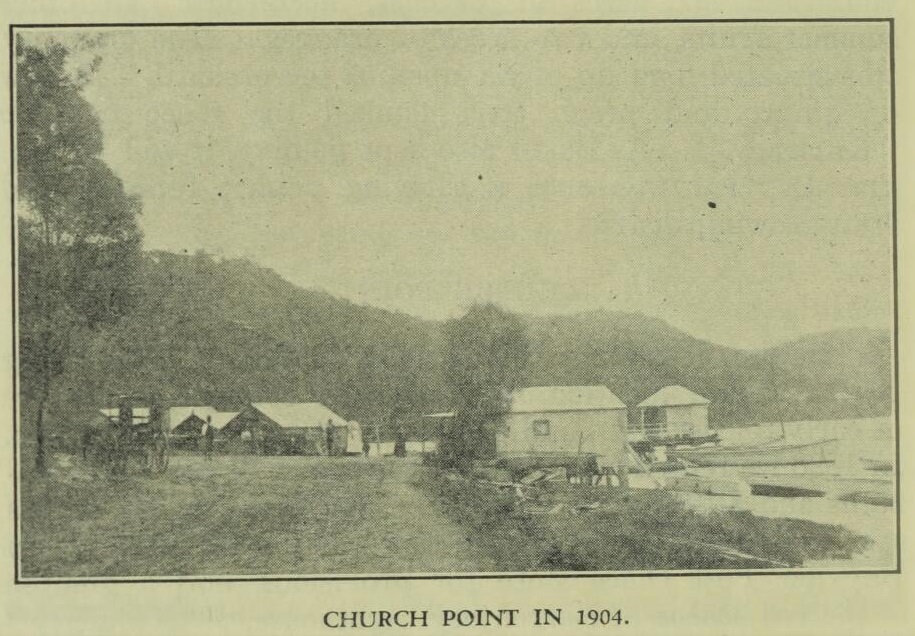
CHURCH POINT IN 1904.
Mr. Wheeler's full anecdote has been digitised by the National Library of Australia is now now available to view online - details below.
Over at Newport and down to Mona Vale, Summer fruits were available to those alighting from steamers for a days vacation:
Sydney Items by "Observer."
SYDNEY TO NEWPORT.
On Saturday last a large number of excursionists availed themselves of the holiday to visit Newport, which is situated at the head of Pittwater, about three hours steam from Sydney; and as there has been for some time continual allusions to the attractions in and around its locality, I took a ticket at a cost of 5s. for the trip, and must say the amount was well spent, the excursion turning out pleasant beyond all expectations.
On landing at Newport, with an appetite sharpened by the steady steam trip of fifteen miles to Barranjoey, against a light north-easterly breeze, and being composed by the smooth run of four miles up the Pittwater inlet, the sight of a good supply of peaches with the bloom on them, pears, apples, and passion fruit, etc., beneath a tent erected by some enterprising local farmer, was a welcome surprise, and it is needless to say the fruit suffered severely.
After this the Newport Hotel was visited, and, as dinner was ready, this had to be attended to at the moderate cost of 1s. 6d. ; but, the time being limited, the roving portion of the excursion began, and I soon found beautifully-shaded glens, with picnic parties sitting upon beds of light green moss, beneath broad-topped trees. There were ferns of many kinds to gather; the native cabbage-tree, rock lilies, and staghorns, could be seen growing to perfection; and then the climbing-plants attached from the bottom to the top of the high gum trees, and drooping, in naturally-formed festoons, from the ends of each bough to the ground, and, passing on to other trees, formed a picture not soon forgotten.
Afterwards the sea beach was reached in about three quarters of a mile from Newport, and we learned of numerous caves to visit, but they were left for a more convenient time, and the fear of being too late for our steamer soon brought us to Newport beach, where oysters are numerous; and there must be good fishing ground near, as some fair samples were hauled ashore by those people who came pre-pared with lines and other articles.
It is lucky the caves and other things we heard of did not tempt us, for it was not long after reaching the wharf that the Illawarra's whistle gave its last shriek, and we were just arranging how to while away the time on the homeward trip, it never being considered pleasant to go back the way you come.
On turning the first point after leaving the Newport wharf, a beautiful scene of hill and dale on both sides of the noble expanse of the broad lake-like Pittwater, with bold grotesque shaped sandstone headland projecting at numerous parts on both sides, and neat white sandy beaches nestled at the ends of irregularly formed bays, stretching 4 miles to Barrenjoey on the west side, and to the Hawkesbury Head on the east, with an island in view between these points, of couchant lion shape, as if guarding the entrance of the angry sea when setting from east to west, and on turning Barranjoey Head for home to observe the crested waves dashing against the rocky projections causing white fairy like foam for a moment, and at times when dashed high enough, the prismatic colors of the particles of sea water were so brilliant that one might be excused for wishing they would not fade so soon.
At this stage of the trip, however, the pleasures ended for me, as the steady rolling waves caused curious feelings, culminating in irregular movements over the side of the steamer, and making me wish myself safely moored in Sydney, as was the case at 7.20 p.m.
1881-SYDNEY TO MELBOURNE AND BACK IN 59 HOURS 15 MINUTES.
It is said that the railway from Gerogery to Albury is not likely to be opened until the end of this month or beginning of February, as it seems there is a lot of finishing-up work to be done before, the officials will pass the line ; and besides this the station accommodation at Albury is not in a very forward1 state. When this section of railway of eighteen miles is opened, passengers leaving Sydney-say on Monday, 7.30 p.m., will be landed in Melbourne on Tuesday, 10.45 p.m., or in 27 hours 15 minutes. From Melbourne it is likely the passenger train will leave at five a.m., and through passengers will reach Sydney at fifty minutes past six next morning, or in 25 hour's 50 minutes, which will be a very great improvement on the present time of 38 hours 15 minutes. Sydney Items by "Observer." (1881, January 6). The Maitland Mercury and Hunter River General Advertiser (NSW : 1843 - 1893), p. 6. Retrieved from http://nla.gov.au/nla.news-article814463
Later, at Palm Beach, two gentlemen, one associated with the subdivision of Palm Beach itself, both had tropical gardens:
AMATEUR GARDENER
PAW PAWS AT PALM BEACH PASSION FRUIT GROWING
(By Redgum)
Nine out of every ten men who take to week-ending by the seaside are quite content to leave all the garden worries behind them. They have quite enough lawn-mowing, path-raking hedge-cutting, rose-pruning and land digging to do on the ordinary home lot, to keep them in good trim the whole year through, without the extra bit of hard work which would have to be done to keep the buffalo grass, the geranium, the plumbago and the hydrangeas alive within sound of the sea.
But there are more men who have made their home within easy reach of the breakers or the calmer waters of a lake or bay, who have taken to gardening because of the pleasure they get out of the- game, and also because of the good fruit and food that can be grown so easily within the home gates. Why grow fuchsias at Palm Beach, when there are so many other tropical and sub-tropical items that, with little trouble, can be made do wonderfully well. Any man or woman can handle hydrangeas or Star of Bethlehem, or salvia; but not one man out of 100 has any idea of how to go about planting mangoes, paw paws, sugar-cane, bananas, custard apples, Avacado peers, taro, Honolulu passions, fruit salad plant, or any of the rarer things which make the work of the amateur happier and easier as well,' Only in favorable places can these things be grown to perfection. The average over-exposed seaside situation Is the last place in the world to do any tree-growing or good gardening. But all seaside homesites are not alike. On some lots Moreton Bay figs, coprosma, Norfolk Island pines, Monterey pines, coral, and the Port Jackson fig are the best subjects for filling in the landscape; tropical lines like paw paws and custard apples should have some protection from strong sea winds and also from the west. '
Any location where the plants can see all they want of the north, and feel all they warmth of the suns’ heat, will do nicely. We are a long way south of the tropics, even at Broken Bay and Barrenjoey. That is the reason why we place all the hotspot plant items against a' north wall, or in a position where the whole of the day's sunlight can play on their stems and foliage. Plant hibiscus or bougainvlllea in a semi-shady place, and the growth and flowering never will be satisfactory replace a young paw paw plant where it will shiver from April to October, and It will never be worth your watching. Good gardening means good placing. Haphazard work rarely gets one anywhere. Not half so much disappointment would be experienced if a little more thought was given to the selection of the tree and plant goods that are selected to do the Important work of brightening up the home landscape. Not everybody who goes to Pitt-water or Palm Beach makes a success of his or her gardening.
SNUG CORNERS A NECESSITY
Many of the homemakers have chosen situations that are quite unsuited for anything but stone-quarrying or for viewing the beautiful landscapes and seascapes. But here and there an expert worker has found a snug corner where the big gales do not tear holes in -the scrub or blow down the trees. Where those men have worked wisely they have done wonderfully well. Wits and ways count for something, even in gardening.
Mr. R. T. McKay, whose home lot stands on the south-east corner of the beach, is one of the men who has worked wonders on his three-acre hillside allotment. He was quick to see that Palm Beach was a place where something quite unusual could be done; and, having hit on the right idea, was not slow In planning his garden on lines which fitted in with his thinking. It was to see the paw-paws that I went to Palm Beach. Bananas, custard apples, and monstera (known as the fruit-salad plant) are common enough along the coastline. But paw-paws and Avacado pears, two of the world's finest fruits, are not seen every day so far south as Sydney. Both are great strangers. There is a big pear-tree In the Botanic Gardens which carries the name so well known on the Californian coast; but that tree, big and all that It Is, does not carry any fruit. Sydney Is just a little too far south to give the tree the conditions It requires.
Mr. McKay's Avacoda pear-trees, being so beautifully placed, might behave quite differently. Time only will tell. Someone along our coastline should try hard to make a success of this pear-shaped Item, which can either be eaten with salt or with sugar. We have been too slow in getting In touch with the alligator or Avacado pear. In America it is one of the choicest things put upon the home tables. Things are quite different with the paw-paws, of which Mr. McKay has several well-grown trees that only recently were carrying full heads of green and golden fruit. The paw- paws I saw hanging under the umbrella of green leaves with which this tropical' fruit tree crowns its head, were good enough for any home table. I heard that the flavor of the fruit ripened naturally is splendid. There will be quite a dozen trees of one age and another on that hillside at Palm Beach. Many small things which are still in their infancy are not yet counted as trees. Their good time is coming. Paw-paws will one day be as conspicuous as bananas round Pittwater, where there are thousands of locations which would suit the fruit trees down to the ground. It Is only a matter of procuring a few seeds from someone in Brisbane. The young plants grow and thrive like weeds if the situation is to their liking.
SUGARCANE AT DEE WHY
Lines like sugarcane and sugar bananas, though not common, can now and again be seen along the coastline. These flourish at Palm Beach, and in many other corners around Pittwater. Sugarcane is the most decorative of all the giant grasses for a hot spot along the coastline. Any of the purply-blue strains are more than decorative. Once planted, the cane will hang on for years. Custard apples and monstera, the first a full-sized tree and the latter a sort of a shrubby climbing plant, grow enormously, and fruit freely. The former is now in full flower, although the fruits are only just over; and the latter is holding a batch of sizy, green fruits that will be ready for the salad bowl before the autumn. This monstera holds several flavors in its six-sided sections. It is good and safe to take in small quantities, but must not be eaten too freely. Custard apples are full of food values, and should be freely grown anywhere there is a chance of holding a tree together.
The mango, also, is one of Mr. McKay's interesting trees. Already he has several specimens in fruit. Later on he hopes to have more trees on his holding. Mangoes are not quick growers. They take years to mature. But once a tree has age and size to its credit, there Is little or no trouble ahead of the owner. Good named varieties should be brought from Brisbane, as chance seedlings are never too sure. Then there Is one big plant of a new passionfruit from Honolulu, known to and sold by the traders as Honolulu Marvel. That passionfruit Is to have a big place on the Australian coastline. It Is an Immense grower, a heavy cropper, and has more skin color than anything else In the fruit world. The fruit portion Is not quite as tasty as Is that of the old purple sort, but It is quite good enough to make a splendid addition to any fruit bowl. Mr. McKay's vine has given him great pleasure, and has provided numbers of ripe fruits for distribution to friends along the coastline. I was only prepared,' to see something with about the same habit of growth as an ordinary purple passion fruit, and was surprised when the vine to which I was taken had run over three spans of trellis about 10 feet long by 10 feet high, and was carrying big fleshy leaves with wiry stems thicker than heaviest Angers.
"Every ripe passionfruit has been saved and sent off to friends who have a chance of growing the vine successfully. On the first try-out, the fruit seems likely to make a good hit. The color of the outer skin Is a rich cadmium yellow, with a touch of sage green here and there by way of contrast. In flavor, this novelty Is only a little less acceptable than the old sort. If the habit of growth of the plant at Palm Beach can be taken as an evidence of its true work, then Honolulu Marvel will not be a stranger for long on the warm coastline of Australia.
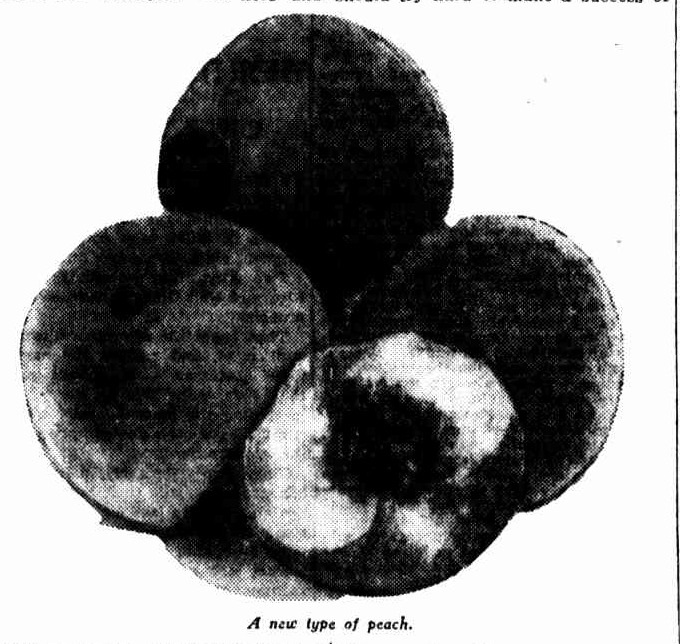
A new type of peach.
AMATEUR GARDENER (1929, January 5). The Sun (Sydney, NSW : 1910 - 1954), p. 7 (LAST RACE RESULTS). Retrieved from http://nla.gov.au/nla.news-article230377677
Palm Beach Pioneer
JACK RALSTON and his bride Nora McAuliffe, after the wedding will go to Honolulu, and doubtless Jack will revel in the long, rolling breakers there. When Jack was only a lad he used to be often seen speeding over the breakers on his surfboard at Palm Beach. The late Mr. J. T. Ralston, his father, was one of the pioneers of Palm Beach, and in the garden around the shack he planted every sort of tropical fruit. He called the place by the longest of Kipling's words, Warragaborrogarooma.
When holidays came, young Jack Ralston travelled to Palm Beach by road and river, and then walked over the hill from Pittwater to the Bay, as that was the only way to go then. The present owner of the garden which Jack's father planted is very proud of the large custard apples that grow so well in that sheltered corner of Palm Beach. Intimate Jottings (1934, August 25). The Australian Women's Weekly (1933 - 1982), p. 22. Retrieved from http://nla.gov.au/nla.news-article47495610
These small insights, and this great digitisation program being pursued by the State Library of New South Wales, are a great reminder that this place was once a food bowl, or should that be 'fruit bowl' for the rest of Sydney and for places far from here:

.jpg?timestamp=1570144050514)
.jpg?timestamp=1570144077512)
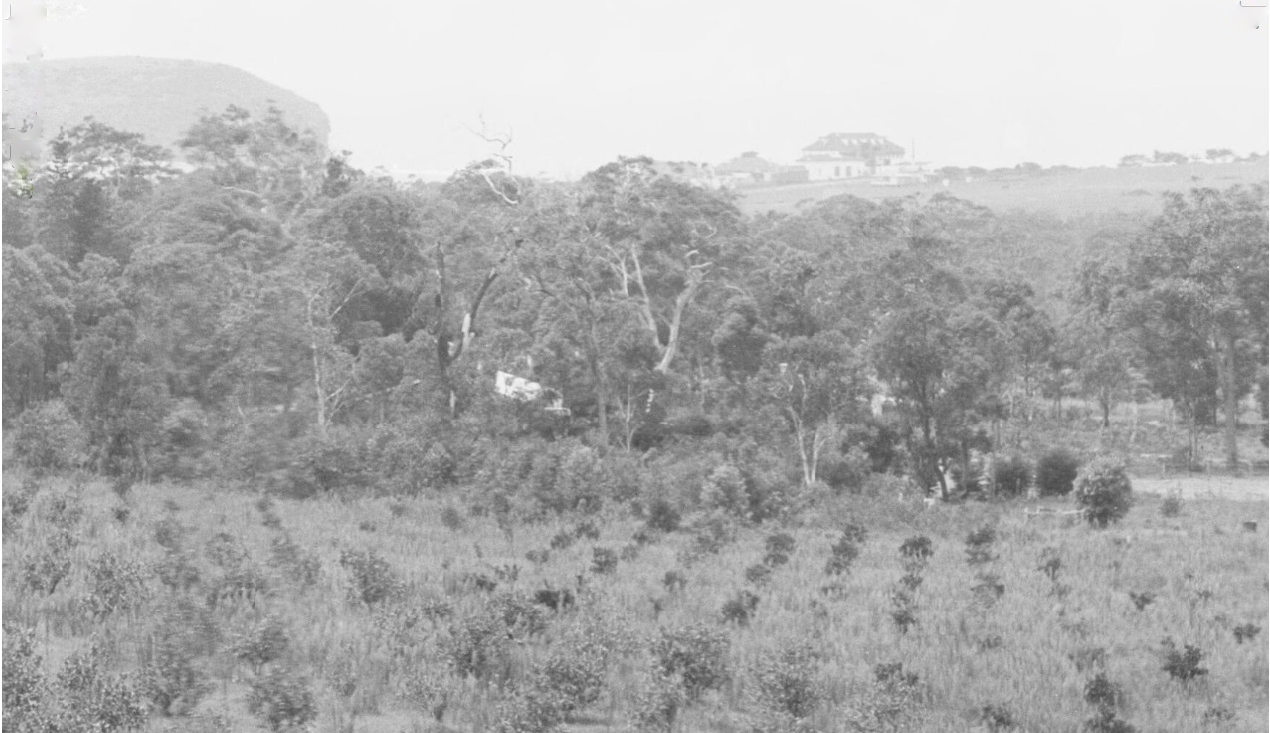
.jpg?timestamp=1570144130410)
.jpg?timestamp=1570144155794)
And of course, we all know Winter in Pittwater is not only a great time to get in the garden, it's also one of the best Seasons to enjoy our great outdoors - the Summer crowds have all gone home, the wildlife and sea life has come out of its hideaways and freely can be seen for those looking, it's a good time to curl up with a good book and a piece of fruit, and you may even catch your supper, as it was in the Winter of 1938:
The Best Time of the Year "Say the Hibernating Palm Beach Regulars
Who thought Palm Beach shut up shop for the winter . . . not NANCY SNEDDON and GORDON MACKAY.
Below : How to spend a week-end at Palm Beach when you have got. the place to yourself .... PERCY SPENDER'S idea.
Above : Now the crowd's gone, the JOHN RALSTONS feel there's room to fish. Nora has a wound mark on her finger to prove, her fish that-got-away story. John -just has the story.
A book and MRS. ROBERT MAC-KAY on the "piazza" at Toko are very good company. Regular Palm Beacher MRS. PERCY SPENDER. likes society's playground best as a winter retreat.
Above right: DR. ROBERT MACKAY has a soldering job on the tank at Toko his idea of week-end fun. Left: THE DAVID FULLERTONS, as, well known on the local' links as Barrenjoey on the headland.
Below: The beach's first permanent camper, BEATRICE CUMMINGS. says loafing in the winter sun is the life. Below: Mrs. GEOFF MAITLAND finds the winter sun on her on front doorstep, with Roslyn and baby Evelyn. Below: Neighboring Whale Beach's best known dog, BOOZER . with Mrs. FAY GEHDE and niece, RONDA KINNINMONT.
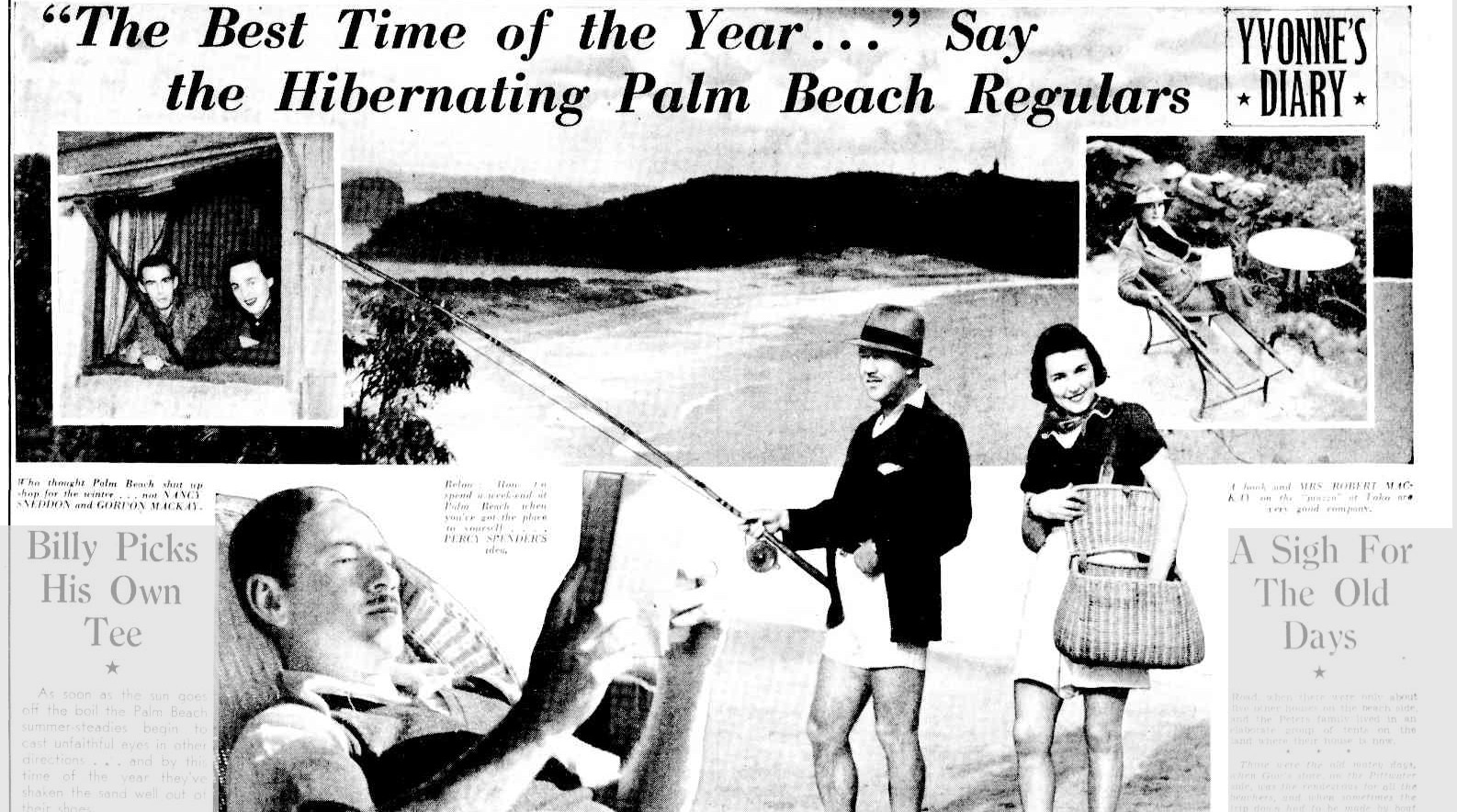
.jpg?timestamp=1624098864408)
.jpg?timestamp=1624098897224)
"The Best Time of the Year "Say the Hibernating Palm Beach Regulars (1938, June 19). The Sun (Sydney, NSW : 1910 - 1954), p. 1 (Women's Section). Retrieved from http://nla.gov.au/nla.news-article231038817
A Sigh For The Old Days Road, when there were only about five other houses on the beach side, and the Peters family, lived in an elaborate group of tents , on the land where their house is now.
Those were the old matey days, when Gow's store, on the 'Pittwater side, was the rendezvous for all the beachers, and when sometimes the trip down had to be made by boat from Newport to Gow's because the roads were blocked.
Whale Beach, next door, was hardly recognised as a beach at all in those days . . . but Mrs. Fay Gehde had discovered it, and built Mount Tomah . . . the third house there. The car used to be parked where the road ended and the rest of the trip was done on foot. The first permanent campers at Palm Beach were Mr. and Mrs. Laddie Cummings. Five years ago they put up what was then a very modern mod. con. camp behind the golf clubhouse . . . and have been going there for holidays and week-ends ever since. They're golfers, too . . . Beatrice is captain of the Northbridge associates.
In between trips to Canberra the Percy Spenders go' to Palm Beach to retreat, relax, and read . . . Percy's engrossed with "Josephus" at the moment . . . they'll probably be spending the law vac. In July at the Beach. Dr. and Mrs. Geoffrey Maitland were down last week-end in Lady Maitland's stone house, Lethington. Alice tells me her mother, Lady Carruthers. has had her first air mail letter from daughters Peggy and Mrs. K. Mnclntyre . . . just arrived in England by the Orama after a wonderful trip. They've been doing London with Lady Maitland, and say Lady M.'s looking mighty fit .. . she's keeping house for Dr. Herbert Maitland in Surrey.
The name Ralston, of course, is synonymous with Palm Beach . . . Nora and John are down most winter week-ends. Nora's got the fishing bug badly . . . she and John make a twosome in a boat off Lion Island and or round the corner to Whale Beach . . . it's becoming quite the thing among the marrieds down there. Even Nora's town interests at the moment are Palm Beachy . . . the Surf Life-Saving Club's dance . , . they're trying Grace Brothers' new auditorium this year . .. and it's on July 7. A Sigh For The Old Days (1938, June 19). The Sun (Sydney, NSW : 1910 - 1954), p. 1 (Women's Section). Retrieved from http://nla.gov.au/nla.news-article231038521
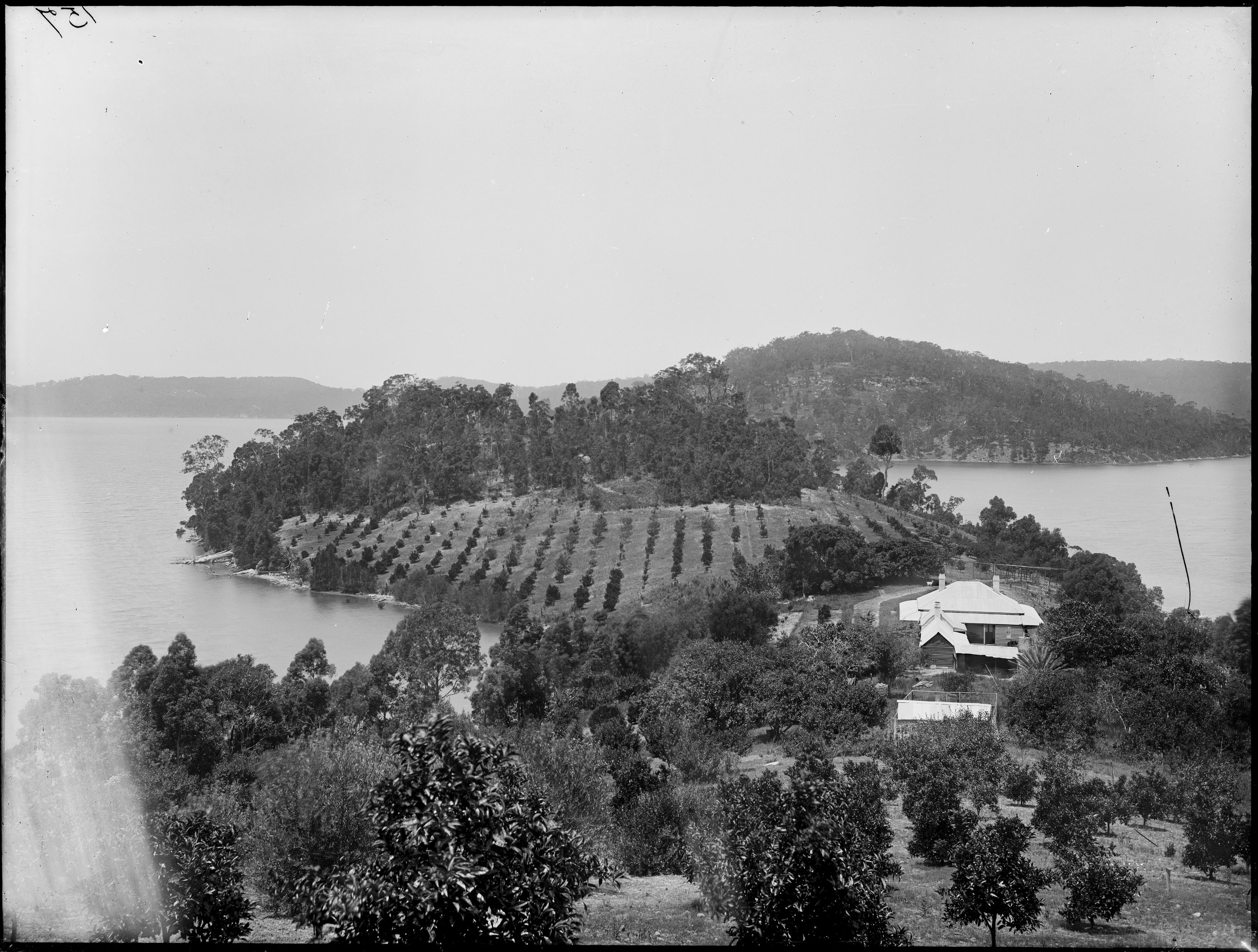
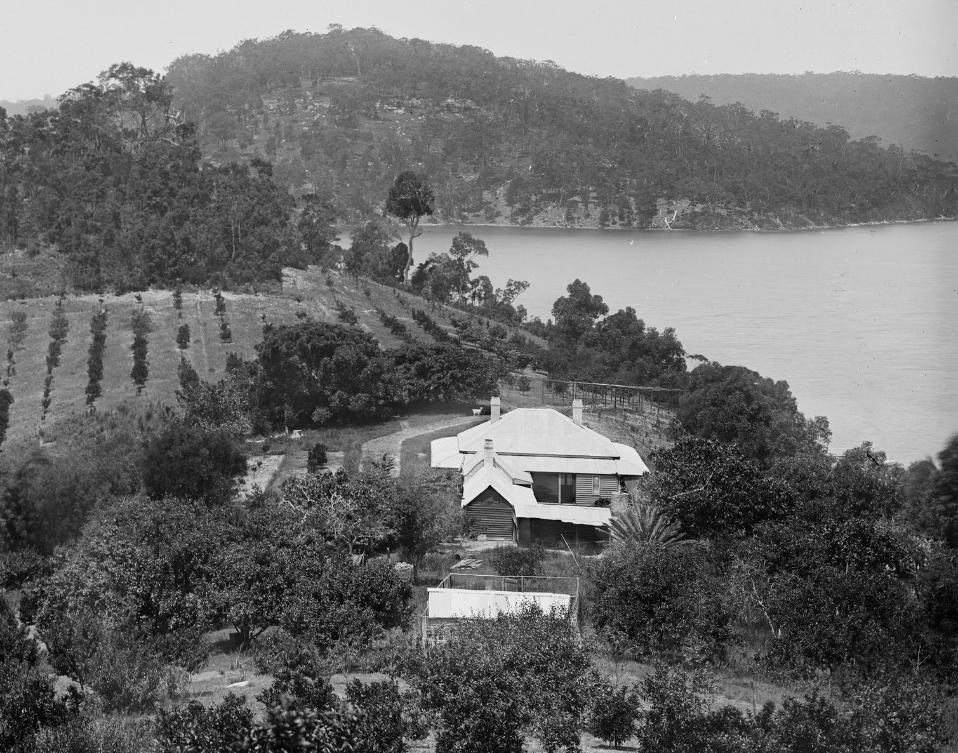
'Orange Orchard' by Charles Kerry, circa 1884 -1888. From Tyrell Collection, courtesy Powerhouse Museum - Rocky Point, Pittwater
References And Extras
- TROVE - National Library of Australia
- State Library of NSW
- Pittwater Summer Houses: Rocky Point And Elvina Bay Peninsula - A Place Of Holiday Songs and Operas In Ventnor, Fairhaven, Trincomalee and Maritana
- The Early Days of Bayview, Newport, Church Point and McCarr’s Creek, Pittwater By J. S. N. WHEELER. Journal and proceedings / Royal Australian Historical Society, Vol. 26 Part. 4 (1940) Pages 88, 7905 words. Call Number N 994.006 ROY Created/ Published Sydney : The Society, 1918-1964. Appears In Journal and proceedings, v.26, p.318 (ISSN: 1325-9261) Published 1940-08-01. Available Online: HERE
- Roads In Pittwater: The Bay View Road
- Katherine Mary Roche - Pittwater Matriarchs series 1
- Waratah Farm: Ingleside - The Narrabeen Plum
From the State Library of NSW website:
The State Library’s unrivalled collections comprise over 6.3 million items including photographs, paintings, drawings, printed and talking books, architectural plans, maps, newspapers, microfilm and microfiche, oral histories, films and videos, computer software and other objects. The collection is large, diverse, and highly valued and used by many, including students, academics, researchers and the creative industries.
Under the Digital Excellence Program, the NSW Government has contributed significant funds to help fast track the Library’s digitisation program and to upgrade its digital infrastructure. Since 2012, the Library has embarked on a 10-year digitisation strategy that will help cement the Library's status as a world-leading library and centre for digital excellence. The Library is digitising our iconic, at risk, and highly valued collections to make them accessible online. Digital material is being created and preserved on a scale never before seen in Australia.
Despite this massive effort, the sheer size of the collection means a large portion of this extensive material may never be digitised. In order to respond to the increasing requests for more of the collection to be made available online, the Library has established the Open Digitisation Partnership Program.
The Open Digitisation Partnership Program will assist the State Library to digitise collection items that may otherwise remained undigitised. The Program enables the Library to enter into agreements with external partners who wish to propose and digitise parts of the State Library collection. The partnership arrangement will in turn allow the Library’s partners to generate a return on their digitisation investment.
The Library continues to support the principle that digital conversion does not create new copyright. Any materials digitised under the Open Digitisation Partnership Program must either be free from copyright restrictions, or have copyright permissions obtained by the digitising Partner.
The Open Digitisation Partnership Program will be accepting Requests for Proposal from August 2018 for review during the subsequent two months. After that date, respondents may submit a proposal or multiple proposals at any time with review dates to be determined.
More information about the Open Digitisation Partnership Program is available from ODPP@sl.nsw.gov.au

.jpg?timestamp=1570144050514)
.jpg?timestamp=1570144077512)

.jpg?timestamp=1570144130410)
.jpg?timestamp=1570144155794)
_____________________________________________________________________________
ROBINSON. — The Funeral of the late Mr. ROBERT ROBINSON, of Church Point, Pittwater, will take place THIS (Tuesday) AFTERNOON, at 3, at Independent Cemetery, Rookwood. Friends will kindly take funeral train leaving Mortuary station at 2.20 p.m. WOOD and COMPANY, Undertakers. Telephone, 726. Family Notices (1896, December 1). The Sydney Morning Herald (NSW : 1842 - 1954), p. 8. Retrieved from http://nla.gov.au/nla.news-article14077784
NSW BDMs: ROBINSON ROBERT 14152/1896 Parents: BENJAMIN ANN registered at MANLY
Manly to Broken Bay.
A PICTURESQUE AND HEALTHY TRIP.
(BY "ST. MAGNUS.")
Sydney and neighborhood abound in lovely scenery, a harmonious blending of land and water, embellished by art, a mingling of many colors and tints that is always pleasing to the eye and charming to. the senses. So numerous indeed are the beauty spots of the metropolitan districts, and so various in their scenic beauty, that one is sometimes at a loss from, which to choose as the most agreeable to spend a holiday. To the lovers of nature, and to those who love to gaze on everchanging scenes, perhaps Manly, and the road along the beach past the Narrabeen Lakes and on to Newport, Bay View, and Broken Bay affords as agreeable and instructive, an outing as any. At all events the route has the charm of comparative newness, because for some unexplained reason it has only been of recent years that the magnificent harbors of Pittwater and Broken Bay, with their lovely scenery and fertile lands have received even pass-ing attention from the great body of tourists, holiday-makers, and settlers, who are ever on the outlook for something new. The district may be easily reached by land via Manly, or by water via Broken Bay. From Manly two lines of coaches are in active running, and make several trips per day to suit the running of the Manly ferry boats and the Post Office schedule time. The distance from Manly to Bay View Post Office is only about 11 miles, and to Newport Post Office the distance is not much longer. The road is a most picturesque one throughout.
One of our illustrations shows a last glimpse of a corner of Manly Beach seen as the town is left behind on the road to Narrabeen. The road then runs through a bit of primeval bush, with its varied colors of Australian evergreens and flowering plants, and then past a settler's cottage with its modest clearing and gay colors of exotic fruit and flower blossoms. Now past the Deewhy Inlet and headland, and Long Reef jutting out into the ocean, then through the village of Narrabeen, where there is ample hotel accommodation, and which has now become a very favorite pleasure resort for Sydney people. The drive is now across the substantial bridge which spans extensive Lake Narrabeen, which abounds in fish and wild fowl (see illustration), and onward in graceful curves around breezy Bulgoa Head open to the surging waters of the vast Pacific Ocean.
For a great part of the distance the road follows the beach, and although at present the whole face of the country is mostly in a state of nature, yet it is easy to see how vastly it could be improved by planting rows of Norfolk Island pines (Araucaria excelsa) and sand-binding grasses as at Manly. Occasionally a lot of green pasture land is passed, and one of the sights of the road is the Salvation Army Home, as it stands on a bold, rocky hill, commanding a fine view of the cultivation patches and a wealth of gay colors.
At length the Rock Lily Hotel is reached, and here is refreshment for man and beast. A few yards be-yond here the road branches, one to the town of Newport and Barrenjoey Lighthouse, and the other to Bay View Post Office arid Telephone Office and Church Point.
At Bay View the expansive waters of Pittwater and Broken Bay in all their glory lie disclosed to view. Our illustration gives a very good idea of the scene. In the foreground is Bay View House, vine-yard, orchard, Post and Telegraph Office, the property of Mr. J. J. Roche. In the near view is Pittwater, extending its broad and deep arms to the right and to the left, and in the distance is Broken Bay, with Lion Island barring the passage way, so named because of its resemblance to a lion couchant. Only half the scene described is represented in the picture, but the varied panorama of headland jutting out beyond headland, with the intervening bays and arms as they sweep inward between the wooded head-lands, gives a good idea of what the other side is like. Broken Bay is, as is well known, one of the most magnificent harbors in Australia, with plenty of deep water and ample scope for the largest ships that sail the ocean. Its vicinity to Port Jackson has, up to the present, destroyed its chances of becoming a commercial centre, but no one can doubt that the day will come when it will be the seat bf a prosperous population with cities and towns within its borders, and railroads and ships bringing goods to its marts. At present it is merely used as a haven of shelter by storm-tossed ships, yachting parties, and an occasional excursion steamer from Sydney. At present its population is mostly com-posed of private gentlemen, who have residences among its beauty spots, the summer residences of business men from the metropolis, a few professional fruitgrowers, with a scattering of business men and fishermen.
Bay View, Pittwater-An Arm of Broken Bay.
From Bayview the road, a very good one, winds around the beach, disclosing as every vantage point is gained new beauties of land and water. Around here are some very good orchards, with trees laden with fruit, and the homesteads peeping out from masses of evergreen foliage, with an extensive vista of land and water. In a charming spot on a sloping hillside, with such a fore-ground and a craggy background Professor Ander-son Stuart has a summer residence and orchard. Mr. W. G. Geddis has a neat residence on a pleasant point. Mr. W. Baker has an orchard with some magnificent trees, while on a commanding bluff is Mr. John Poster's residence and orchard. Mr. A. McIntosh's residence is also hard by.A Corner of Manly Beach.
This road ends at Church Point, a lovely spot commanding a view of Pittwater; the town and hotel of Newport at the head of Navigation, Broken Bay, and Barrenjoey directly in front ; Scotland Island and Towler's Bay right across the water, with the long and deep arm known as McGarr's Creek on the left.
On the Towler's Bay side there are several residents who pull across the water to the wharf at Church Point and meet the steamer from Sydney or the coach from Manly, as the case may be. The dynamite powder hulk is moored in Towler's Bay, with residences on shore for the officers in charge. Mr. Robert Robinson has his residence of Raamah at the same place. Mr. Robinson informs me that he can grow to perfection such tropical fruits as bananas, guavas, ginger, mangoes, pineapples, Brazilian cherries, &c. This fact will demonstrate that there can be little or no frost in this locality.
Other residents of this side of the bay are Mr. F. Chave, Wood-lands, who has a very nice orchard, mostly summer fruit ; Mr. E. C. Johnstone, who has a nice residence and orchard; Mr. A. Steffani is another prominent resident, while the residence of the firm of Flood and Oately occupies a lovely peninsula in the quiet waters of the bay. Mr. Geo. Brown has a residence and an orchard in the neighborhood, and there is also a small church and cemetery at Church Point. Careel Bay and Valley (see illustration) is situated to the left of the entrance to Broken Bay, and is considered one of the most beautiful of the many points of interest on the whole water system of Broken Bay. The bay is spacious and deep, and the valley, which comprises an area of about 1000 acres, is shut in by a bold and rugged mountain chain. The valley is the homestead of the late Mr. John Collins, and most of the land still belongs to the Collins family. New Brighton is situated here, a favorite resort for excursionists by steamer from Sydney. Large ocean steamers can run right up to the wharf at Newport, and there is ample water for even larger vessels. From the Basin, Broken Bay, the distance to Peat's Ferry is about four miles, and there are long and deep inlets which penetrate the land for a great distance on either hand. On the right from Broken Bay extends Brisbane Water up to Gosford. The above is but a glance at some of the more salient features of this extensive inland water system, with its deep and broad bays and inlet beyond inlet, lying within the many folds of the bold projecting headlands and wooded hills; in fact the whole is a perfect maze of waterways, head-lands, bays, and islands, which must be seen to be properly appreciated, and the water abounds in fish of various descriptions.
The land, as seen in its bold outlines from a distance gives one an idea of sterile beauty, but on closer approach and investigation it will be found that, while there are many rocky ridges and promontories, there are also deep alluvial valleys, composed of very good soil for fruit-growing and even dairying purposes. Most of the land is a light sandy loam, but there are spots of excellent soil. Stretching back from the bay there is Mr. J. J. Roche's orchard, composed of very good soil. Beyond for several miles the soil is generally good, and at Mr. Austin's Cabbage Tree Valley Orchard the soil is of an excellent quality.
Turimetta township is situated about 1½ mile from Bay View, on the road to Manly, and fronting the ocean beach. It cannot boast of many inhabitants as yet, but Mr. E. Doublet, of Sydney, has a promising young orchard in the vicinity. The Rock Lily Hotel is also here, Mr. Leon Houreux proprietor, and to which there is attached a neat flower garden and orchard.
Mr. Henry Ball, Rosebank, and Mr. J. Shaw, are both fruitgrowers of this neighborhood. At Newport, a township which boasts a good hotel, Post and Telegraph Office, Town Hall, boarding-house, and several private residences, there are several small orchards. But neither in orcharding, dairy farming, or fishing has the resources of land and water been as yet developed to their fullest extent; in fact, in these great industries a commencement is just about being made, which in time will no doubt develop into remunerative and extensive industries. In the hands of Mr. Roche and a few others, fruit-growing and poultry farming is a paying industry and will be sure to extend.
Our illustration, " A Cluster of Lemons," grown by Mr. Roche, on his Bay View Orchard, will com-pare favorably with any fruit of the kind grown in this country or any other. The lemons, which are of the Lisbon variety, and are very juicy, are simply superb, and grow close to the salt water in the greatest profusion ; and oranges, which are of the Siletta variety, are among the sweetest and best ever grown.
On Mr. Roche's property are several small caves, interesting as the unmistakable residence of generations of blackfellows, and the shells and debris collected show ages of habitation, and what is now used as manure.
The flora of the district is varied, as may be supposed from the climate and soil. Grey gum, spotted gum, ironbark, blood wood, and turpen-tines, and others of the eucalypti develop into lofty trees, which cover the whole face of the country and give it a densely wooded appearance. In the olden days large quantities of excellent timber was shipped from the district, and there is still large quanti-ties obtainable, although not so handy as desirable. A dense undergrowth occurs in suitable situations, prominent among which are the numerous palms common to the coast. The baroneas, flannel flowers, waratahs, fuchsias, &c, all grow in the most bewildering confusion ; rock lilies, stag-horns, and other epiphytal plants cover the rocks and trees, while a perfect maze of ferns cover the sward wherever they can find root for themselves, from the tender maidenhair to the more lofty fern tree. Ever-flowing streams of water pour down from the mountain sides, in some instances forming cascades of considerable volume, which still further enhance the beauty of the scene.
In short this favored region has every resource calculated to render it a fit habitation for man ; a salubrious climate, fertile soil, plenty of wood and water, and within easy distance from market. Its fisheries alone, if energetically prosecuted ought to return a revenue sufficient to support a large population, while its close proximity to the metropolis and many beauties ought to attract a constant stream of tourists. The reason the district is so backward in respect of permanent settlement is no doubt because there are so many other localities where the land is more easily cleared and the soil of a better quality. One drawback has been that much of the best of the land has been locked up from settlement by large landholders. Tourists and summer visitors are now beginning to pour into the district. Many Sydney business men are buy-ing properties and building cottages thereon for summer residences. The district has has rapid and efficient and cheap, communication with Manly by coach, but what is required to bring it within easy reach of the metropolis is a tramway or light line of railway. Under existing circumstances one can leave Church Point at 6.15 a.m., and reach Circular Quay by the Manly boat at 9 a.m., but a railway to North Sydney would do the journey much quicker and with more com-fort. As a place of resort for holiday-makers Pittwater and Broken Bay has many, attractions and as a place of residence for those who like marine views it stands unsurpassed.

Cluster of Lemons-Grown by Mr. Roche, Bay View. (For letterpress see article " Manly to Broken Bay," on page 19.)
THE NARRABEEN LAKES-A PICTURESQUE HEALTH RESORT NEAR MANLY. (See letterpress on page 19.) Manly to Broken Bay. (1893, November 11). Australian Town and Country Journal (Sydney, NSW : 1870 - 1919), p. 19. Retrieved from http://nla.gov.au/nla.news-article71191632
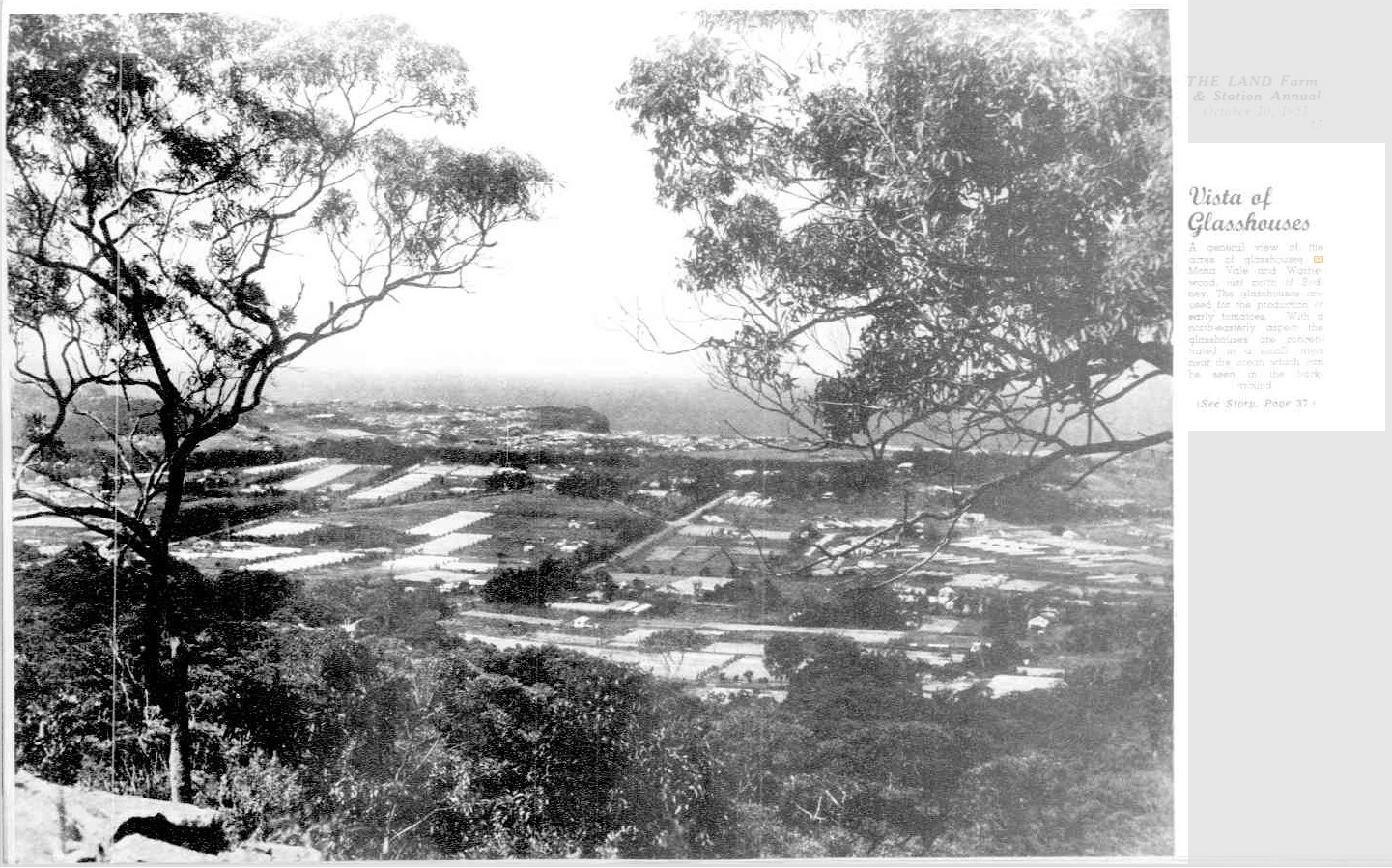
.jpg?timestamp=1619251207636)
